Summer, 2020
Surviving 2020: Industrial Forecasts for A Post Covid World Black Entrepreneurs in Hemp
Summer Solstice: An Epic Virtual Conference
Past, Present and Future: Hemp’s History in Pictures

Inside Regenerative Agriculture
All One: Exclusive with David Bronner
By:
 Powered
Powered
Hello


Hemp friends and welcome to the latest edition of the Let’s Talk Hemp digital magazine. It is with great respect that our community has banned together during these unprecedented times of pandemics, protests, riots, social distancing, masks, etc...and have joined the virtual realm to Experience Hemp. Our team is committed to reconnecting with you all in person when large trade shows and conventions are allowed to resume. We genuinely appreciate your understanding and support today more than ever!
We would like to thank all of the content contributors who joined us for this issue as well as for our second installment of our Experience Hemp virtual platform. Our Let’s Talk Hemp Library and NoCo Vault are loaded with exceptional information and insight into all that is taking place throughout the hemp industry supply chain. Never a dull moment as we have all learned one way or another over the months, years, and decades depending on how long one has been operating in the business of hemp and cannabis.
Last, but certainly not least, we would like to emphasize that WAFBA - We Are For Better Alternatives...the umbrella which houses Let’s Talk Hemp, NoCo Hemp Expo, Southern Hemp Expo, and several other hemp related entities, is a platform built for creating positive change. That includes the true and complete ending of cannabis prohibition and the war on drugs. That includes the shift from conventional agricultural practices to organic and regenerative agricultural practices. That includes beginning the shift in consciousness from a fossil fuel based society to a bio-based society. And most importantly, it includes a shift to human freedom and true equality for all, regardless of skin color, gender, sexual orientation, religious affiliation, or country of origin. Particularly manifested in the importance of the current Black Lives Matter Movement symbolic of so many of society’s ills and potentials for healing. There is one race, the human race. There is one planet, Earth. There is one way forward, together.

With Love & Respect, Morris, Elizzy, Lori WAFBA
NOCO
Producer
Morris Beegle
Executive Director
Elizzy Knight
Operations & Finance
Lori Buderus
Programming & Content Coordination
Morris Beegle
Steven Hoffman
Speaker Coordinator
Kayla Haddix-Heard
Customer Service
Joanne Lovato
Kristen Kunau
WAFBA/NoCo Hemp Expo Business Development

Preston Whitfield
Sean Murphy
Webmaster
Debby West
Graphic Design


Ben Wright
WAFBA Social Media
Cait Curley
Volunteer Coordinator
Brandi Higdon
Public Relations & Compass Natural Marketing
Steve Hoffman
POWERED BY HONEYSUCKLE MAGAZINE
Publisher
Ronit Pinto
Executive Editor
Jaime Lubin
Creative Director & Digital Mag Design
Samuel C. Long
Managing Editor
Neha Mulay
Senior Editor
Elise Bortz
Chief Copy Editor
Rina Lokaj
Honeysuckle Writers
Ronit Pinto
Neha Mulay
Jaime Lubin
Taylor Custis
Elise Bortz
Cortney Connolly
NoCo Writers
Jacob Bish
Emma Chasen
Andrew DeAngelo
John Dvorak
Meri F. Harli
Steve Hoffman
Becky Long
Jean Lotus
Dan M.
Darwin Millard
Danny Murr-Sloat
Brian O’Hearne
Agnes Ostafin
Melissa Peterson
Kim Rael
Christina Sasser
Luke K. Stanton
Jeffrey D. Welsh
Producers’ Letter – 2
Mastering Climate Control for Indoor Grows – 6
Future-Proof Your Hemp Extraction Business – 10

Summer Solstice Virtual Conference Program Guide – 12

Summer Solstice Speaker Guide – 14
Dasheeda Dawson Joins Portland’s Cannabis Program – 18
All-One: An Exclusive with David Bronner – 22
Emperor of Hemp: Jack Herer – 26
Weather: Biggest Risk to Growing Hemp – 28
Regenerative Agriculture: Healing the World with Hemp – 34 Mechanized Drying – 38 Hemping While Black – 40 Fit for Purpose – 50 Land of the Free – 53 History of Hemp in Pictures – 54 Value Added Through Nanotechnology – 70 Hemp Battery? – 74
New THC Regulations Mean for CBD – 94 1996 Cannabis Cup Report – 98 Cannabis Extracts – 104 Joint Venture – 116 Total Crop – 120 Hemp in 2020 and Beyond – 124 No Justice – 126
The Future of Hemp in a Post-COVID World – 32
What


Mastering Climate Control
By Danny Murr-Sloat
From years of cultivating craft cannabis at AlpinStash, I’ve learned that a proper growing environment is critical to a healthy garden. Yet, it’s often one of the last aspects facilities invest in and implement. I recommend professional cultivators place primary importance on creating the optimal environment for their plants. Properly integrating environmental controls--temperature, humidity, air movement and filtration, CO2 enrichment, and insulation--dramatically affects the success of your harvest. Here are some core tips to begin navigating this aspect of cultivation.

a minimal amount of cooling, either planning to add more as needed (which can be a lengthy, expensive and messy prospect and is usually required in a pinch) or hope to deal with the heat issues that will inevitably arise. This approach leaves the grow open to many issues, which reduces both quality and yield.
Temperature Control
You must be able to easily control the temperature of your grow, on both the hottest summer days and coldest winter nights. When using CO2 enrichment (as I discuss below) optimal leaf surface temperature is around 85 degrees. Night temperatures shouldn’t dip below 75 degrees. I recommend at least half a ton of cooling per 1000 watts of non-ducted HID light used. Add at least 10 percent more cooling than you think you need. It’s much better to have it and never use it, than to need it during that critical time in bud development and not have it. Many try to slide by with

6 LetsTalkHemp.com
Control for Indoor Grows

While proper heating is much easier and cheaper to achieve than cooling, it still needs to be factored in. The bottom line: paying for an energy-efficient and overpowered AC system properly designed for your growing space from the get-go will lower your cost per pound. Your yields will go up, maybe even by 30 percent or more, and it makes the difference between a successful harvest and a failed one. Be sure to have your heating and cooling systems serviced on a regular basis and replace filters every three months.
vent flooding. Larger commercial units are often fixed in place and run off of a 240 volt line. I run a Surna 300 PPD dehumidifier and have had good luck with it.
Air Movement and Filtration
Humidity Control
Humidity, along with temperature, dictates how much a plant is respiring, which in turn dictates growth, photosynthesis and the uptake of nutrients and water. Like proper heating and cooling, controlling the humidity is crucial to optimal plant health, yield and quality. In most cases, commercial grows need to remove humidity rather than create it. Sometimes the AC system can handle the dehumidification requirements when it’s running. However, AC systems do not usually run at night. That alone is often not enough. There are many different dehumidifiers on the market. Compact units can be used to control the humidity in a smaller space. Or, multiple small units can be used to control the humidity in larger areas. Plumb them into a condensate line or floor drain. Or, place them over a rolling Brute trash can, which acts as a reservoir for the reclaimed water. These make great portable dehumidifiers. Dump the reservoir every day or two to pre-
Air movement helps prevent micro-climates, reduces heat build ups, prevents stagnant air, reduces molds and mildews, dissuades pests and strengthens plants. It’s important that all areas of the grow space have some form of air movement -- no dead spaces. In general, plants like a moderate breeze. Blasting plants with fans causes wind burn, leaving buds dry and crispy. Strategically placing wall-mounted oscillating fans is a sensible practice. Adequate air movement throughout the foliage helps prevent fungal diseases such as powdery mildew and bud rot from attacking the plant and dissuades soil-borne pests like fungus gnats from taking hold. Plus, the swaying of the branches strengthens the plants. Since heat builds up the most directly below the light, adequate air movement at the canopy and between the lights keeps the plants cool and happy.
Filtration can be broken down into two areas: odor control and sterilization. Many municipalities require odor control. Some areas tolerate a certain level of smell while others don’t allow any at all. Charcoal filters and inline fans, constantly scrubbing the air, work well to control the scent of can-
LetsTalkHemp.com 7
nabis. The key is to not duct any inside air outside. My setup (multiple 48 inch by 12 inch filters with 10 inch inline fans) scrubs the entire room multiple times a minute. Ionic cleaners are tempting as they do a good job at controlling odor and cleaning the air in one go, but they can kill the aroma of the buds.
Often overlooked, air sterilization can save a harvest from mold. UV sterilizers are the most effective. Units can be freestanding filters, or can be incorporated into AC systems. All of my air intakes and AC ducts have UV sterilizing units in them. I went with a simple Honeywell UV100E2009 SmartLamp Ultraviolet Air Treatment System. It’s important to note that these can sometimes leak UV light into the grow area, which could negatively affect the plants during the night cycle. UV sterilizer units placed near the coils of an AC system greatly reduce mold, mildew and bacteria growth. UV bulbs should be changed out every year.
shut-off system be installed with the CO2 system. Too much CO2 can be fatal and these systems shut off the CO2 and sound an alarm should something happen.
Insulation
Insulation will play a major role in how energy affects your grow space, as well as condensation problems you may have to deal with during cultivation. With our temperature swings here in Colorado, having enough of the correct insulation means the difference between a condensation-free grow and indoor rain storms. Traditional fiberglass and plastic bat insulation won’t cut it due to the heat and humidity characteristics of a grow environment. I’ve witnessed condensation rain (literally) on plants all day during winter months. This causes mold to grow on the plants and insulation. Instead, use at least three inches of spray foam insulation. It costs more money up front, but it will save a ton of money and headache and heartache down the road.
CO2
CO2 enrichment of the grow environment can increase plant yield vigor and raise the optimal temperature from 78 degrees to 85 degrees. For plants to use the additional CO2, it’s important to keep temperatures between 82 and 86 degrees. Because cannabis grows faster and bigger when enriched with CO2, the grower often needs to increase the amount and/or frequency of feedings. The two main ways of adding CO2 are burners and tanks. Burners create CO2 by burning either propane or natural gas and create heat and humidity as a byproduct. They’re more geared towards greenhouses and many municipalities do not allow the use of CO2 burners in an indoor setting.
Alternately, tanks are filled with CO2 to deliver gas to the grow. Consult a local CO2 company to find the right configuration. An external tap or external tanks system allows for refills to be made without having to enter the grow environment. Both CO2 burners and tanks should be hooked up to a CO2 PPM meter with a photo sensor. These units only dispense CO2 when the lights are on (or if the sun is up for greenhouses) and keep the grow environment enriched with the proper levels. I run my CO2 at 1500 PPM for most of the flower cycle, and recommend an emergency
Danny Murr-Sloat transitioned off 19 different prescription medications and lost 70 pounds with the help of MMJ and the process of learning to grow his own medical cannabis. This journey inspired Danny to develop AlpinStash, the licensed Colorado-based company known for healthy and beautiful cannabis cultivated using all-natural methods. As owner and master grower, Danny oversees AlpinStash’s operations and also consults in the industry on business development, cultivation technique, compliance and transparency. Small-batch, grown-with-love, hand-trimmed and glass-cured to perfection, AlpinStash is a leader in the craft cannabis movement.
http://alpinstash.com
8 LetsTalkHemp.com
For more tips visit AlpinStash on Youtube here
--
LetsTalkHemp.com 9 powered by Let's Talk Hemp Media WE ARE FOR BETTER ALTERNATIVES Virtual FALL 2020 - DATE TBA JOIN US FOR PHASE 3 OF THE 2020 EXPERIENCE HEMP / NOCO HEMP EXPO VIRTUAL CONFERENCE & TRADESHOW SERIES more information @ nocohempexpo.com
Future-Proof Your Hemp Extraction Business
By Meri F. Harli
Living in an age of tremendous uncertainty and economic upheaval can be extremely challenging. But with great adversity there lies great opportunity. A valuable takeaway from this time of pandemic-related shut downs—and their resulting economic fallout—is how to be prepared for disaster scenarios. Preparation is the ability to meet challenges from a place of proactive strategic thinking rather than acting in blind panic with knee jerk reaction.
So how can you prepare your hemp extraction business for something like COVID-19? Or, for something like last year’s vape scare? And, beyond just survival how do we actually thrive during tough times?
For a recent webinar, we enjoyed a lively discussion with Andy Joseph, Founder of Apeks Supercritical, and Ben Stephens, Founder of Delta Separations, both veterans of the extraction business who have endured many ups and downs to build their businesses. As they discussed joining forces under the new Processing Solutions by Gibraltar banner, we also focused on three critical aspects of future-proofing your extraction business to ensure success.
1. Extraction Equipment: Modularity vs. Singularity—Why Bigger Is Not Always Better
When considering the large-scale extraction of hemp there is a question that stands out as a topic for debate; is bigger always better?
Ben Stephens, founder of Delta Separations, puts it
like this: “One critical thing that isn’t often considered in these large-scale systems is what we call singularity vs. modularity (one large machine vs. several smaller machines or ‘modules’). In hemp oil extraction, for example, you're dealing with highly volatile, corrosive terpenes that can eat seals very quickly and these need to be replaced. In a large-scale singular system, this can mean that your entire operation comes to a halt and the resulting downtime is a killer for your business.”
Whereas with modularity, your extraction business is much more adaptable and able to respond quickly to unforeseen setbacks. “With modularity, if you have multiple lines, if anything on that first line goes down, you still have the other lines operational. If a machine goes down for example, a part can be shipped to you overnight and you can get back up and running with a minimum of downtime.”
2.

Market Opportunities: Get Ahead of Market Trends to Ride the Next Wave
As mainstream consumers get more educated about all things CBD, hemp, and various minor cannabinoids, new trends are starting to appear in the marketplace. As a hemp extractor it pays to stay informed of upcoming trends, so you can be in the “sweet spot” to meet consumer demand.
Ben Stephens looks into the past to forecast the future.
“One of the challenges we saw with the hemp industry in 2019 was that everyone was going gangbusters because of the high price of distillate and isolate for
10 LetsTalkHemp.com
CBD. Well, that lasted for a shining moment and now CBG is the next molecule people are focusing on. But the concept of singularity vs. modularity is the same. Your hemp extraction equipment has to be flexible and adaptable to produce the next cannabinoid that consumers want. So, you need to take this into consideration before you start making heavy equipment purchases.”
Currently, apart from CBG, some of the latest market research indicates that the new up-and-coming cannabinoids will be CBN (cannabinol), THC-V (tetrahydrocannabivarin), and THC-A (tetrahydrocannabinolic acid). Now is a good time to plan out how your extraction operation will rise to meet the demand for these new cannabinoids.
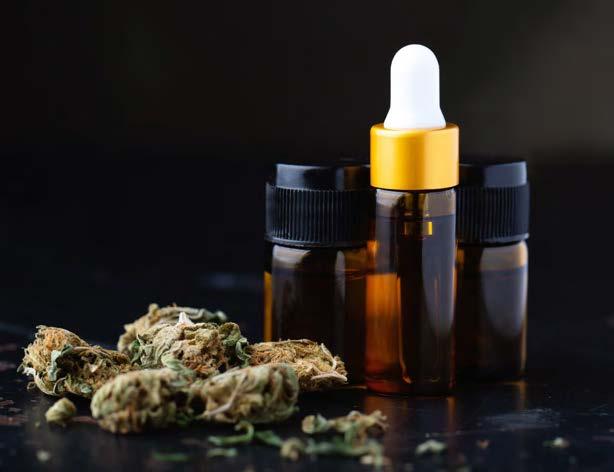
3. Get Certified to Build Credibility and Authority
When you’re starting up a hemp extraction business, it can take time to build trust and reputation in an industry that has come out of the underground only within the last few years. The fast track to building credibility and authority is industry certifications.
Andy Joseph of Apeks Supercritical puts it like this: “Certifications help to answer the question; ‘Hey, can I trust these guys?’ But as someone who wants to buy the best of breed in equipment, I don't have to just take their word for it. I can trust them because they conform to a certification, they conform to specifications that are widely accepted not just in hemp but in other manufacturing industries.”
If you’re considering buying hemp extraction equipment some certifications that Andy recommends looking for are the following:
ASME
CE Marked
ISO 9001
PSI Reviewed
UL Certified to ANSI/CAN/UL/ULC 1389
“Those certifications are going to become very, very important in fact, with regards to future-proofing. Without those certifications, you run the risk, at some point down the road, having equipment that doesn't comply, even though it complied at the time when you bought it. And so, it becomes important to purchase equipment that doesn't become outdated overnight.”
Meri F. Harli is Senior Content Marketing Manager at Processing Solutions by Gibraltar.
Delta Separations | 525 Portal St. Cotati, CA 94931 | (707) 222-6066
Your
16
INNOVATION
Technology Advances Across the Hemp Supply Chain

Joe Witte, VP of Ecosystems and Partnerships, TagOne
Agnes Ostafin, Ph.D., President, Nanoshell Company

Andrew Bish, COO, Bish Enterprises

Mark Reinders, CEO, HempFlax
Joe Hickey, Co-Founder & Chairman, Halcyon Holdings

TUESDAY,
Moderator: Joy Beckerman, Principal, Hemp Ace Regulatory, VP, U.S. Hemp Authority
INVESTOR OUTLOOK Financial Future of The Hemp
Industry
Emily Paxhia, Managing Partner, Poseidon Investment Management


Codie Sanchez, Partner, Entourage Effect Capital

Patrick Rea, Principal, Canopy Boulder
Geoff Whaling, President and Cofounder, Collective Growth Corp.
Julie Lerner, CEO, PanXchange
Moderator: Sean Murphy, Hemp Industry Consultant and Founder, Hemp Business Journal

WEDNESDAY, JUNE 17
FOOD SOVEREIGNTY
Nutrition & Hemp’s Role
Chad Rosen, Founder, Victory Hemp
Winona LaDuke, Founder, Winona’s Hemp & Heritage Farm


Anndrea Hermann, Principal, The Ridge International Cannabis Consulting; Board Member, Hemp Industries Association


Eric Schnell, Cofounder, Mood33 and BeyondBrands

Moderator: Steven Hoffman, Editor, Let’s Talk Hemp Newsletter, Managing Director, Compass Natural





BAST & HURD
Opportunities in Building, Biocomposites, Biofuels & More
Mattie Mead, Founder, Hempitecture
Ed Lehrburger, Founder, PureHemp Technology
Pamela Bosch, Educator, Artist and Hemp Advocate, Highland Hemp House


Patrick Flaherty, Founder, PF Design Lab
Gregory Wilson, CEO, Hempwood/Fibonacci LLC




Michael Fazakas, CEO, BC Hemp Corporation
Moderator: Scheril Murray Powell, Attorney, Doumar, Ellsworth, Lastrom, Voigt, Adair and Dishowitz, and Executive Director, Black Farmers and Agriculturalists of Florida
12 LetsTalkHemp.com LIVE
SESSIONS
JUNE
THURSDAY, JUNE 18
THE 2020 HEMP CROP
Harvesting, Drying, Handling & Finding Markets
Dion Oakes, Co-owner, Wright-Oakes LLC and San Luis Valley Hemp Company
Dani Billings - Cofounder, Nature’s Root; Colorado Hemp Project


Eric Steenstra, President, Vote Hemp
Mike Leago, COO, High Grade Hemp Seed
Moderator: Tim Gordon, Chief Science Officer, Functional Remedies

THE 1 PERCENT SOLUTION
Why 0.3% THC is Arbitrary and Wrong
Courtney Moran, Attorney, EARTH Law LLC


Shawn Hauser, Partner and Chair, Hemp and Cannabinoids Department, Vicente Sederberg LLP

Herrick Fox, CEO & Co-Founder, Meristem Farms LLC



Cary Giguere, Agricultural Resource Management Section Chief, Vermont Agency of Agriculture

Kayla Haddix-Heard, Founder of Hippie Hempster, Speaker Coordinator at CoHempCo


Moderator: Doug Fine, Hemp Farmer and Author, Hemp Bound and American Hemp Farmer


LIVE WEBCAST SUPERSESSIONS
The Experience Hemp SUMMER SOLSTICE Virtual Conference & Trade Show will showcase six 90-minute live webcast Supersessions, offered twice a day, on Tuesday, Wednesday, and Thursday, June 16-18. During the sessions, join in live chats and Q&A with featured panelists, industry speakers, and webcasts.
Hosted by Morris Beegle, Preston Whitfield and Scheril Murray Powell.
LetsTalkHemp.com 13 LIVE
*speakers are subject to change
SESSIONS






























14 LetsTalkHemp.com
AC BRADDOCK Eden Labs
ADRIAN ZELSKI HGH Seed
ALEX BUSCHER Buscher Law LLC
ALYSSA BOSTON Miss Universe Canada 2019
BECKY LONG Thompson Dryers
BEN DROZ The Hemp Guy
BRIAN WEEDEN Zen Lending & Consulting
BRIAN SMITH Big Sur Scientific
BRIAN O’HEARNE Arbol Inc.
BOB HOBAN Hoban Law LLC
BRUCE RAFAEL Leyton
CHRISTINA SASSER Vital Leaf
COURTNEY BARNES Vicente Sederberg LLP
DANI BILLINGS Natures Root
COLE GIBBS Dama Distributing
DION OAKES Wright-Oakes LLC
DOUG FINE Hemp Farmer & Author
EMMA CHASEN Eminent Consulting
GARRETT GRAFF Hoban Law Group
JOHN DVORAK Hempology
JONATHAN MILLER Natures Root
JONATHAN VAUGHT Natures Root
JOY BECKERMAN Natures Root KATHY SANDERS RN-MSN, Port Royal Plants, LLC
KEVIN NOWELL HiLo Seed Company
KIM RAEL Azuca
MARC ROSS Needle Consultants LLC
MEGAN RAPINOE Olympic Athlete, Mendi
RACHAEL RAPINOE Athlete, Mendi
*subject to change
WILLIAM RICHMOND USDA
LIBRARY
EXPERIENCE HEMP

Virtual Conference & Trade Show | June 16-19, 2020
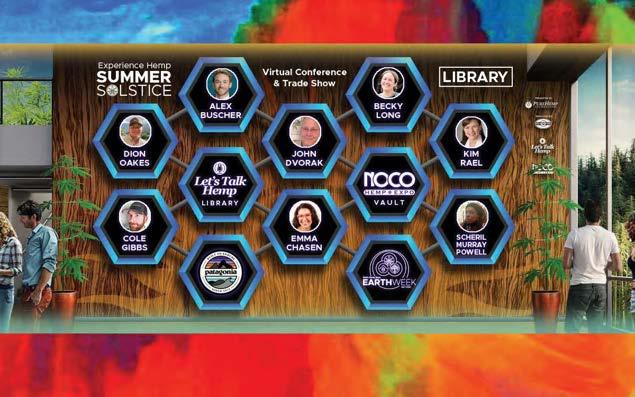
HOURS of HEMP INFORMATION, EDUCATION & ENTERTAINMENT

SUMMER SOLSTICE










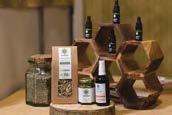























































16 LetsTalkHemp.com EXPO EXPO MAR 5TH & 6TH 2021 SPRING 2021 birmingham FIND OUT MORE ABOUT THE HEMP & CBD EXPO ON OUR WEBSITE WWW.HEMPANDCBDEXPO.COM EXHIBITOR ENQUIRIES SALES@HEMPANDCBDEXPO.COM | +44(0)1773 687 227 5000 attendees 75% b2b visitors FREE registration 150 exhibitors 50+ guest speakers 2019/20 SHOW STATS the uk‘s no.1 cannabis products trade show THE UK'S NO.1 CANNABIS PRODUCTS TRADE SHOW

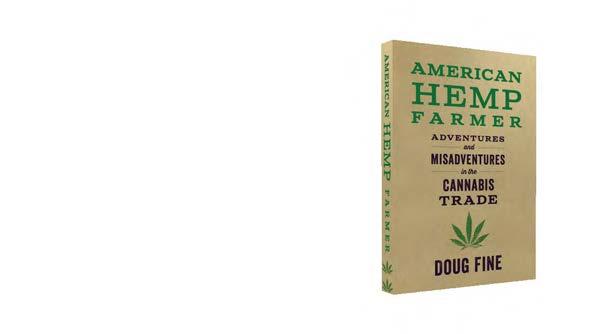

LetsTalkHemp.com 17 CHELSEA GREEN PUBLISHING the politics and practice of sustainable living facebook.com/chelseagreenpub @chelseagreen @chelseagreenbooks WWW.CHELSEAGREEN.COM AVAILABLE WHEREVER BOOKS, EBOOKS, AND AUDIOBOOKS ARE SOLD Look for More at the Summer Solstice Virtual Conference! “A fantastic piece of Americana that shows the way to a sustainable future.” —David Bronner, CEO, Dr. Bronner’s Magic Soaps
BUDDING STUMPTIOWN

DASHEEDA DAWSON JOINS PORTLAND’S CANNABIS PROGRAM
By Jaime Lubin & Ronit Pinto
In recent years, Oregon has been home to some of the most impactful figures and milestones in the cannabis movement. Its capital, Portland, passed a 3% tax on adult-use cannabis in 2016 which has had sweeping effects on city operations. According to the City of Portland, since the tax was enacted, “over $6M has gone toward street infrastructure improvements; DUI training; drug rehabilitation; small business support; economic opportunity, and technical assistance for business owners from communities disproportionately impacted by cannabis prohibition; record-clearing; and other efforts.”
This May, Oregon achieved another progressive feat as Dasheeda Dawson joined the Portland Office of Community & Civic Life as its new Cannabis Program Supervisor. Dawson, an award-winning Fortune 100 executive strategist and author, brings her great significance as a global cannabis advocate to the position. She has over 15 years of business development, strategic management and brand marketing excellence while leading cross-functional teams for philanthropy and businesses. For the past four years, she has worked as an industry educator, senior executive leader, and strategy expert for multiple cannabis businesses, municipalities, and media outlets across the country, creating a multitude of opportunities for professionals to transition into the cannabis sector. Vocal about going “from corporate to cannabis,” Dawson is co-founder of the Cannabis Education Advocacy Symposium and Expo (CEASE), a board member of Doctors for Cannabis Regulation and former Chief Strategy Officer for Minorities for Medical Marijuana. On New Year’s Eve 2018/New Year’s Day 2019, Dawson became the first African-American cannabis business owner to be featured on a Times Square billboard. She shared the following statement on what the appointment to Portland’s Cannabis Program means to her and how she will implement the city’s policies for cannabis equity. Congratulations, Dasheeda!
*This statement was previously published on the City of Portland Office of Community & Civic Life's website:
My name is Dasheeda Dawson and I am the new City
of Portland Cannabis Program Supervisor. As only the third Black woman in the country to hold a cannabis regulatory oversight leadership role, I’m thrilled to be joining the Office of Community & Civic Life team to serve the City and its thriving cannabis community.
AN INTRODUCTION: FROM ADVERSITY TO ACTIVISM
Originally from pre-gentrified Brooklyn, my life’s path has been paved with adversity, largely because of our society’s entrenched inequities. With the support of a diverse community and initiatives like Prep for Prep, a leadership development program that offers promising students of color access to an elite prep school education in New York City, I was able to transform adversity into advantage. I gained access to the highest levels of education and took full advantage of my opportunities, attending Princeton University for my undergraduate degree. Therefore, it wasn’t lost on me the significance of Nicholas Johnson, Class of 2020, making history as Princeton’s first Black valedictorian in its 274 years of existence. Even with my privilege, as a Black woman, I understand that because of systemic racism, there is little to protect me from becoming a hashtag like Breonna Taylor, who was fatally shot by law enforcement while sleeping in her own bed.
For many, this is an awakening to the inequalities that Black, Indigenous, Latinx and other people of color face daily. Millions of people across the world watched the police show brutal disregard for George Floyd’s life. His murder became an alarm clock ringing for long overdue change and action. Many of us have always been fully awake to these disparities, because the skin we have been blessed to live in too often presents the biggest risk to our lives. From police brutality to infant-maternal outcomes, there are very few areas of our society not significantly impacted by pervasive systemic racism that has endured for more than 400 years. Thankfully, change is in motion and I stand in solidarity with those sincerely expressing their outrage, grief and despair for the brutality we have watched unfold.
As I begin my new role with the City, I draw inspiration from the words of the Honorable Charlotte B. Rutherford, a respected Portland activist, attorney and former administrative judge:
LetsTalkHemp.com 19
“Well, to me, civil rights as far as what Black people need or should have had, or will eventually acquire, is a lot broader than law. There’s a lot more to it than what’s written on a piece of paper. And activism is not just front line marching. Activism is taking a role in making things better, whether that’s culturally, educationally, politically, or in the streets.”
Regardless of access and opportunity, the sad reality is that Black people face the specter of constant peril because of racism’s omnipresent threat. The war on drugs, predominantly waged against Black and Brown men, has long been a tool of racial oppression. Marijuana possession and sale, whether perceived or real, has provided an excuse for over- policing, state violence, and law enforcement interactions that far too often end in death for people of color. In fact, cannabis prohibition has led to Black Americans being almost four times as likely to be arrested for possession relative to our white counterparts and remains one of the top reasons for deadly police interactions in our communities. Understanding the role marijuana prohibition has played in my own life has fueled my global cannabis strategy, education and advocacy work for the past four years. I look forward to actively collaborating with all partners and stakeholders to continue building and elevating both the cannabis community and the City of Portland.
PORTLAND: CREATING EQUITY WITH CANNABIS
The City of Portland Cannabis Program recognizes the overwhelming damage caused by 80 years of cannabis prohibition and the major restorative potential of legalization. As one of the first cities in the country to establish a social equity grantmaking program tied to cannabis tax revenue, it also recognizes the tremendous opportunity of dismantling a long-standing construct of racism that persists in the United States. Reinvestment of cannabis tax funds is a logical way to begin repairing the harm, restoring communities and creating more pathways to health equity for communities that have been purposely targeted by unjust cannabis laws. Here in Portland, nearly $1,500,000 has been reinvested to support Black, Indigenous, and other communities of color. The Cannabis Social Equity Grant Fund has supported 34 community expungement clinics, over 2000 legal analyses for expungement, and nearly 300 Portlanders have received specialized workforce training and career development assistance free-of-charge.
Under my leadership, this program will work to uphold the core tenets adopted by the Cannabis Policy Oversight Team (CPOT) and included in its 2019 Annual Cannabis Policy Report: The war on drugs has caused disproportionate harm to Black, Indigenous, and other communities of color. Cannabis should be used as a tool to direct capital resources into these same communities for the purpose of restitution and restoration.
The Bureau is committed to adopting policies, regulations and programs that support equitable access to the cannabis industry, so that communities and individuals that have experienced the greatest harm from prohibition can share in the industry’s wealth.
The City’s processes around cannabis regulation and policy development will be informed, acknowledging the long history of trauma and race-based inequities, particularly the multi-generational impact of cannabis criminalization.
Impacted communities and stakeholders will play a key role in solution-finding, policy and program development, and decision-making.
Strategic recommendations and execution will require City investments of time and resources.
While we continue innovating a model for equity in the cannabis industry, we must also honor the calls for change that have echoed around the globe. We have witnessed the rise of local mobilization and community leaders sparking national conversations. In our unwavering pursuit of justice, let us continue our unified and deliberate actions to see tangible results, both locally and nationally.
Cannabis Program ● 503-823-9333 ● portlandoregon. gov/cannabis
20 LetsTalkHemp.com
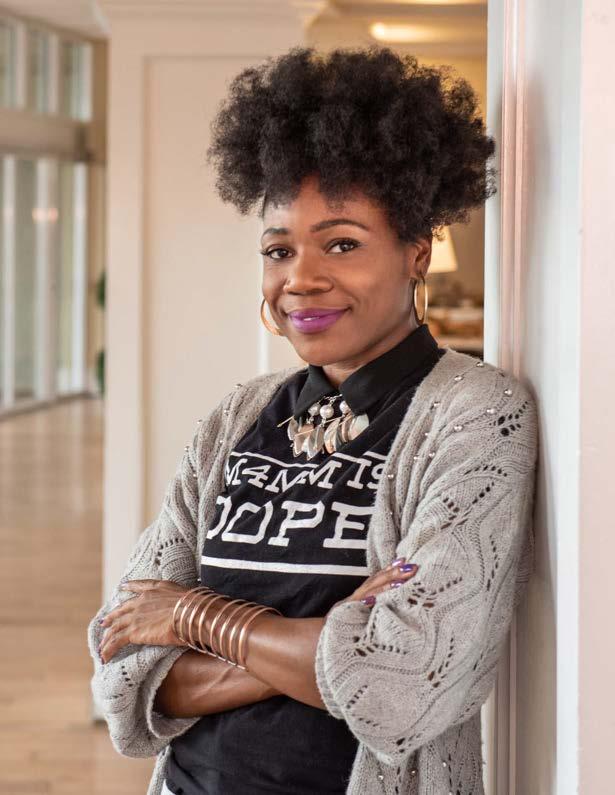
All One
An Exclusive with David Bronner
By Jaime Lubin and
Ronit Pinto
David Bronner is a man on a mission to distill the global experience into its purest essence: Love. As CEO of Dr. Bronner’s Magical Soaps, he is also completely re-engineering the idea of corporate social responsibility through his grandfather’s progressive vision “We Are All-One or None.” “All-One,” or “unity experience” as David will sometimes call it, is the concept that everyone must recognize the interconnectivity of living things everywhere and work together for social, environmental, and economic responsibility. In his case, “CEO” stands for Cosmic Energy Officer, and with good reason, as a major part of this initiative is integrating psychedelic medicine with holistic healing regimens, regenerative agriculture, and spiritual understanding.
“I really resonate to the All-One philosophy,” Da-
vid explains. “What does it mean at a quantum level that my body is one with the world? There’s not a difference between the world and me… [In the world unity experience], your ego self dissolves and you experience a much bigger self that you’re part of, a bigger reality process… There’s something way bigger than our individual lives going on. And when we can connect with that, that’s incredibly powerful. For the Western psyche, at this point where we’re just so media-saturated and so disconnected from nature, these medicines are coming in at a crucial time. And cannabis of course is one of the most crucial allies, [helping us understand] the responsibilities that we have to consume correctly and consciously that’s in balance with the larger earth and the animals and plants that feed us.”
This May, Dr. Bronner’s - the leading soapmaking company in the American natural market - donated $1 million to the Psilocybin Initiative in Oregon, which
22 LetsTalkHemp.com
and use of psychedelic mushrooms as plant medicine. “We face enormous challenges globally, and psychedelics – used responsibly – can help us solve them,” David attests. “Oregon has a ‘treatment, not jail’ effort [which is helpful].” In the case of people who need psychedelics to wean off harmful drugs like opioids, he adds, “Being an addict is not a crime, it’s a health problem.”

Psychedelic medicines, in David’s view, are “crucial to integrate as fast as possible so that we can wake up in time” to tackle social and economic problems consciously. He is a board member of the Multidisciplinary Association for Psychedelic Studies (MAPS), an organization to which Dr. Bronner’s donated over $5 million for psychedelic research. The funds particularly support the Zendo Project, a program that encourages safe, productive environments for psychedelic experiences and proactive harm reduction that lowers the annual number of users admitted to psychiatric hospitals or arrested.
“Psychedelics helped wake me up to penetrate the BS-ness of [the world]… and understand that there is a deep truth going on,” David says. “I think God’s love for the world… is incarnated in everyone who wakes up and participate in that love of creation.”
These sentiments are typical of David, who steers Dr. Bronner’s to reflect a collective energy with investments, dollars and action hand-in-hand. He has a great legacy to protect. The “All-One” philosophy was pioneered by the original Dr. Bronner, David’s grandfather Emanuel (Emil) Bronner, whose unique approach to business
created a foundation for what would become a force radiating across every significant aspect of modern life.
A trained chemist, Emil was a third-generation master soapmaker from the Jewish quarter of Lauphein, Germany. He emigrated to the United States in 1929 following unbearable clashes with his family due to his strong personality and Zionist ideals. (Emil even dropped the word “Heil” from his last name, originally “Heilbronner,” upon Hitler ’s ascendancy to power.) Predicting the rise of the Nazi party, he pleaded with his parents to emigrate with him, but they refused. His last contact with his parents was in the form of a censored postcard saying “You were right. —Your loving father.” Emil subsequently discovered his parents were murdered in the Holocaust.
In the U.S., Emil’s visionary temperament caused controversy and he was at one point committed to Elgin State Insane Asylum in Illinois for vehemently espousing his views. He escaped the asylum in 1945, began producing Dr. Bronner ’s signature peppermint oil soaps in 1948, and by 1950 started using the business as a platform to connect and share his “All-One” vision with the public. By the 1960s and 70s, Dr. Bronner’s had become the iconic soap of the era, with its powerful message for peace.
With that history in mind, it’s easy to see why David Bronner today is so committed to healing the world. He took the helm of the company with his brother Michael following Emil’s passing in 1997; they spent a year training to run the operation with their father Jim Bronner, who died from cancer in 1998. David, who gradu-
LetsTalkHemp.com 23
ated from Harvard with a degree in biology, has grown Dr. Bronner’s from $4 million in annual revenue to over $120 million. Under his leadership, the company supports causes such as regenerative agriculture, animal welfare, fair labor practices, ethical supply chains, and integrative medicine, among others. These tenets all find roots – pun intended – in the hemp and cannabis communities, where Dr. Bronner’s has chosen to be a highly visible partner.
“We try to translate that cosmic all-one philosophy in really pragmatic ways,” says David. “That’s primarily regenerating the earth and taking care of our own supply chains, first and foremost. Making sure our farmers and workers are treated right. And we have a very mixed religious supply situation – most of our supply projects are composed of two or more faith traditions, which is really cool.”
Social equity, fair labor and ethical employee practices mean everything to David and his family. With the company’s growth, they implemented a 5-1 compensation plan which means that Dr. Bronner’s has capped the company’s top salaries at five times that of the lowest-paid warehouse worker. There’s a beautiful unity in knowing that Dr. Bronner’s oils, as David notes, “are mixed in major Abrahamic faith traditions,” with olive oils for the company coming from Muslim Palestinian farmers in the West Bank, a Jewish family farm and an Arab Christian project in Israel. Other suppliers include a Catholic-Muslim household with a Buddhist and Hindu workforce in Sri Lanka and a Catholic-Muslim workforce in Ghana supplying palm oil.
“We’re all cells in the body of God,” David states. “I value every sincere seeker and every [belief system]. No path is wrong when they’re all approached with an open heart and mind and no judgment, totally valued and respected… I think the medicine path should be integrated with a meditation path and a prayer practice. That’s where the integration work… between all these really profound and deep medicine experiences can happen.” The profundity seems to be exploding now, with fate causing a pandemic, economic injustice and worldwide protests erupting simultaneously. In an act of solidarity with the Black Lives Matter movement, Dr. Bronner’s released an official statement reading in part, “It should not take another police murder to force our society to say enough is enough and to demand systemic change to end racial injustice and inequality. That need is long overdue. We urge our employees, customers, and other companies and businesses to proactively engage in anti-racism, and to work for racial justice… To us,
‘All-One’ means that Black Lives Matter.” The statement also announced that Dr. Bronner’s was pledging $25,000 to organizations in Minnesota and nationally working to end anti-Black racism and abuse, as well as $250,000 funding criminal justice reform measures toward ending mass incarcerations of people of color for low-level drug offenses. “Oregon has a ‘treatment, not jail’ effort [which is helpful].” In the case of people who need psychedelics to wean off harmful drugs like opioids. He states that addiction is a health problem not a crime, which brings us to the War on Drugs.
**See full video here:
“There is deep systemic racism in our [country’s] founding that has been translated in different ways throughout our history,” David observes. “Jim Crow, after the Civil War, was a new system of racial control… Then you saw the rise of mass incarceration after the drug war, a systemic new racial control… All this is somewhat unconscious. But how does this happen when we’re supposed to be officially colorblind?”
One answer may lie in another question: How do we spark understanding of universal love in a fractured society? For this, David explains that psychedelic therapy can help tremendously.
“I think direct unmediated experiences of love is key,” he asserts, adding that psilocybin (psychedelic mushrooms) can effectively open pathways to our consciousness that we otherwise wouldn’t be able to access.
“There’s a Johns Hopkins study that says… psilocybin therapy [allows] people to have direct mystical experiences that have generally only been reserved for our highest artists and mystics. Like the indigenous sacramental approaches can occasion them for all of us. You can just have that directly. It’s the higher power.”
Moreover, David urges everybody to take care of each other so we can move toward holism: “You need to translate experience into actual relationships and honor everyone… I think that there is a nexus of self in responsibility that we are accountable for our decisions. But [we must understand] we are inter-subjective creatures made up of each other and the world we live in, so we’re both individual and collective of the world, and separate from it, and all the paradoxes [that creates].”
For the man who gleans his biggest inspirations from
24 LetsTalkHemp.com
spiritual shifts, it feels like Gaia’s awakening is happening very fast indeed. “I’m cautiously optimistic about integrating all of our medicines as soon as possible, and psychedelically healing,” David reflects. “Hopefully global citizenry goes up by another decade… [Let’s] get the collective behavior change and policies in place that could really give us a shot. Harmonizing the economy and agriculture on a regenerative basis, stopping us from going off the climate change cliff, and we need to solve social and income inequality in this country and around the world.”
Lots to accomplish, but the mind behind Dr. Bronner’s has shown he can master the impossible. Let’s show the world that we’re also ready to get connected. For the planet’s sake, for our children and grandchildren, for our very lives and all that hangs in the balance, this is the one trip we simply have to take.

LetsTalkHemp.com 25
Emperor of Hemp: Jack Herer
By Andrew DeAngelo
Industrial hemp was forgotten for decades until Jack Herer wrote his book, The Emperor Wears No Clothes, in 1985. The story of that book being researched and written could fill many volumes. I only got to be with Jack on a small part of that journey when he did Volume Two, and it went something like this:

I graduated college in 1989, in the Los Angeles area, and I needed some weed to sell. Or I had some weed and needed to sell it, one of those two. My older brother Steve was a friend of Jack's and knew he lived nearby. He hooked me up with the "Hemperor," so I could carry on spreading the seed that would save the planet, a popular phrase of Jack's in the book. It was how I made a living.
I remember meeting him for the first time in a parking lot in the Valley. It was a hot, smoggy day that you could cut with a knife. I showed him the weed sample, or he showed it to me, and the discussions of a deal began to unfold. After the terms of the deal and the logistics of the transaction were settled, Jack was hungry and wanted to get a hot dog from a nearby stand.
He ordered two dogs with everything and two more for me before I could let him know I didn't eat meat. When Jack made a decision and began to voice it, there was no turning the man back, and it was virtually impossible to say no to him. I was only 21 at the time, Jack was already a legend, and I needed to sell or buy some weed from him.
I ate the hot dog.
Before I could finish two bites, he had finished both of his in the most exuberant eating habit I had ever witnessed before or since. Jack didn't eat his food; he devoured it ravenously. And he talked the entire time he did so. He would spit out rather large pieces of food and get them all over his beard as he talked, or more accurately, preached.
Then, without any warning at all, he grabbed one of my hot dogs, engulfed it and continued talking. He did not ask or even gesture if it was okay to eat my hot dog. Before I could protest, the hot dog was gone, and he was making a move for what was left of the one I was eating. Somehow, I fought him off and got the rest of it down my gullet.
It was at this moment that I knew I was in the presence of a man possessed of divine madness. Jack was stonecold crazy and I damn near freaked out and ran away. The truth was, I was pretty crazy myself and that was what it took to stand by the cannabis plant in 1989, the way Jack and I did. You had to be a little crazy to take those risks and carry that message. There were plenty of other ways to make a living, that's for sure.
That summer I worked on editing his book and creating the bibliography with him. Jack would insist on large doses of cannabis or other visionary plants as we worked. At the start, I tried to explain to him that this was fairly organizational work and it might be best not to consume those offerings, but that was quickly and ferociously rebuked, and we carried on high as kites.
It took an enormously long time to finish the edit and bibliography but we eventually did.
26 LetsTalkHemp.com

donation will go towards releasing cannabis prisoners & rebuilding their lives.
Follow us @lastprisonerproject
FREEDOM TO 24365 TO DONATE There are over 40,000 cannabis prisioners in the U.S.
Your
LASTPRISONERPROJECT.ORG
TEXT
WEATHER: Biggest Risk to Growing Hemp
By Brian O’Hearne
According to the 2019 U.S. License Report from Vote Hemp, 230,000 acres of hemp were planted last year, with as much as 40%-50% (115,000 – 138,000 acres) not harvested due to crop failure, non-compliant crops and other factors. Most of that lost production was due to adverse weather!
The most consequential and uncontrollable risk as a grower is adverse weather. From now until you harvest your 2020 hemp crop, it is impossible to manage the
weather, but it is possible to manage the consequences of unfavorable weather that may emerge. Depending on where your fields are located, summer heat, hail, too much rain at harvest, early frost or freeze, can cancel all your efforts and investment in your hemp crop.
Federal Crop Insurance Programs. Federal crop insurance was authorized in the 2018 Farm Bill but, due to the lack of production history, a pilot program was not available until 2020. That program has several limitations, most notable for now, is that the signup deadline was March 15, 2020. It also had many other limitations: 1) prior production history; 2) under a sales or processor contract; 3) impractical crop
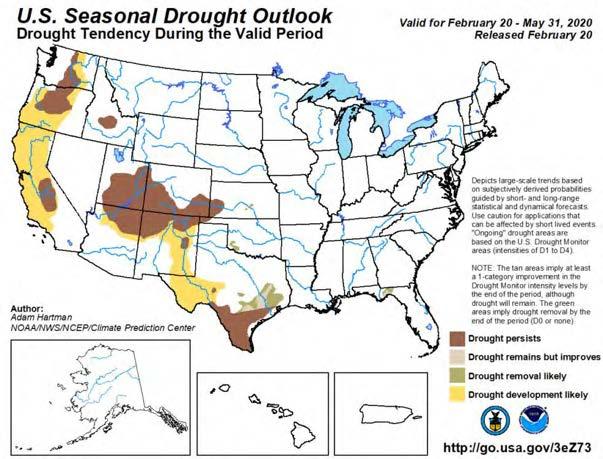
rotation requirement; and 4) probably most significant, coverage is voided if the crop tests above .3% THC. The THC testing requirements raise questions of how the testing is to be done, how frequently and when. Also, if the crop tests hot, there are then additional requirements and costs to dispose of the crop.
What causes elevated THC? The biggest contributor to elevated THC is weather stress. This can take the form of hail, excess heat, drought and even too much rain in places where hemp does not like wet roots. 41% of the tested Arizona hemp crops had elevated THC levels in 2019, raising some questions about growing hemp in southern climates. With respect to hail on hemp, there are questions about loss adjustment as well as if the crop needs to be taken to maturity and then tested. If the THC is above limits, then, even though hail damage occurred, coverage would not apply because of the requirement to destroy the crop would render the crop worthless.
Adverse weather events in 2019. Hail was widespread last year, reaching into the Pacific Northwest (PNW) as well as the Rockies and east of the Rockies. The Southeast and Midwest had wet planting conditions, which caused extra expense and limited production with late planting and a shorter growing season that pushed the

crop into risk for early fall freeze. Along the Gulf and Atlantic Coasts, an active hurricane/tropical storm season resulted in lowered yields and crop damage. The Southwest and West Coasts were suffering from droughts, which caused elevated heat and fires. An early start to the rainy season in the Pacific Northwest led to problems at harvest. Finally, record early fall freeze from Montana through Oklahoma caused significant damage.
2020 Outlook. Wide-spread wet planting conditions east of the Rockies, except in Texas, could again make the crop subject to a shorter growing season and risk a wet harvest and possibly an early freeze. An early start to the rainy season in the PNW could also be in the cards with a developing La Niña in the Pacific, which causes the PNW to be wetter than normal. Droughts in the PNW look to continue and expand to the Southwest per the latest Drought Outlook from May 21. This year looks to have an active tropical storm/hurricane season, which puts the Southwest at risk from Pacific storms and the Gulf and Atlantic coasts at risk of excess rain and wind. In fact, as of the date of this article (May 31), we have already had two tropical storms, with Arthur brushing North Carolina earlier in May and Bertha taking a bullseye into South Carolina
LetsTalkHemp.com 29
on May 27. Two tropical storms occurring before June 1 have only happened 5 times since records began in the 1800s. Interestingly, three of the five times have occurred in the past eight years, i.e. 2012, 2016, and now 2020 (1887 and 19082 being the other two years).
losses;
Gaps, limits and exclusions under the USDA and other programs; and
Lack of viable solutions for processors, investors and lenders who can’t access the USDA or private crop-hail insurance today.
Arbol’s HEMProtect™… Multiple peril weather protection which mitigates the most critical outdoor crop weather exposures, including:
Too wet at planting, requiring replanting and associated expense and reduced yields or prevented planting and a complete loss;
Excess heat, causing THC levels to increase (resulting in a complete loss, destruction of the crop, cancellation of crop hail/USDA crop insurance);
Too wet at harvest, causing mold, mildew and other conditions that could prevent harvest altogether;
Early fall freeze, which can also cause catastrophic
Request for Proposal. For those hemp industry participants who would like to receive further feedback or a customized program proposal, please contact the author.
Brian O’Hearne is Head of US Sales for Arbol Inc., the leading provider of private weather protection for outdoor hemp cultivation. Brian.Ohearne@arbolmarket. com. 913 749 7738


The Future of Hemp and Cannabis in a Post-COVID World
By Kim Rael
This is a time of great disruption, yet despite the current chaos, I am optimistic about our future. The COVID-19 pandemic has thrust all sectors of the economy into unprecedented territory, and businesses are struggling to navigate this new landscape. With disruptions to supply chains, sales, and operations, the cannabis and hemp industries are no exception. We must continue to focus, first and foremost, on the health and well-being of our employees, consumers, and community members. At the same time, we now must proactively move into the post-COVID era for the benefits of our industry. I believe the hemp and cannabis industries are primed to emerge from the COVID-19 pandemic stronger than ever, as necessary regulatory evolution and emergent consumer trends have forged new momentum for the industry.
tive agenda. Consequently, I predict that COVID-19 will catalyze thoughtful, expansive legalization as states and local governments seek alternative sources of revenue to ease the COVID-19 induced budget crisis.

Additionally, I believe Congress will pass the long-overdue STATES Act and SAFE Banking Act. These practical and straightforward policy changes support economic growth and job creation without draining the Treasury. This is the most cost-efficient move Congress can make as a compliment to other traditional stimulus initiatives that, although needed, require massive fiscal outlay. Congress should also expedite pending legislation, mandating that the FDA adopt safe and effective regulations allowing the industry to prosper. This is vital for the growth of the ingestible category, which currently lacks clear affirmative federal guidance, and is consequently weighed down by convoluted state-by-state regulations.
Cannabis, including hemp, is one of the fastest growing industries in the country, yet it continues to be bogged down by outdated policy and regulatory constraints. The current regulatory framework is one which constrains economic growth through an incredibly counterproduc-
Clearing the confusing regulatory constraints for the ingestible category is especially critical as the pandemic has catalyzed new demand for ingestible products.
The indisputable data on COVID-19’s unforgiving toll on patients with compromised lungs, as well as residual concern over last year’s “Vape-Gate” is creating a growing desire for ingestibles (including edibles, tinctures, sublinguals, beverages, etc.) Solid edibles alone have experienced a 37% increase over the last fiscal year. In the post-COVID-19 world, consumers will choose products that align with their informed health and wellness interests. Ingestible products, both easy to use and effective, must fill this growing demand.
Kim Rael is President and CEO of Azuca, a privately held, investor-backed company that commercializes a line of chef-quality, edible products, and licenses its fast acting TiME INFUSION™ process to quality brands looking for a fast-acting cannabis edible technology.

Azuca’s patent-pending TiME INFUSION™ process enables a predictable and controllable experience every time. Azuca’s hemp-derived CBD products are sold online at azuca.co/shop. Azuca TiME INFUSION™ is available at Mayflower Medicinals in Massachusetts and in the Wana Quick gummies line in Colorado.
The cannabis and hemp industries will emerge from the pandemic stronger than ever. This doesn’t mean there won’t be significant changes afoot. There will likely be shakeups in the industry: companies with poor products, mismanagement, and murky business models will not succeed, while those with compassionate and strong leadership, high quality products, and intelligent business models will swiftly rise above the rest. I believe that the challenge and disruption of COVID-19 will ultimately lay the groundwork for the next ten years of growth in the cannabis and hemp space.
Regenerative AG: Healing the Planet with Hemp
By Christina Sasser
The world as we know it is experiencing a time of great transformation. Climate change is now considered a major public health emergency by leading scientists around the world. The world needs a multifaceted approach to combat climate change, and one important way to do so is through radical adjustments to farming practices. According to a 2019 report from the U.N. Environment Programme, agriculture is currently the planet’s largest form of land use, occupying 40% of the earth’s surface and responsible for 25% of greenhouse gas emissions. Regenerative agriculture is a holistic system of farming principles that could change these trends. It seeks to rehabilitate and enhance the entire ecosystem, actually “improving the resources it uses, rather than depleting them.”
Regenerative agriculture is unique in its ability to both reduce greenhouse gas emissions and to also capture
them through carbon sequestration, which is the longterm removal of carbon from the atmosphere. When plants photosynthesize, they take in carbon dioxide from the air and transform it into carbon that the plant uses to grow. The excess carbon created during this process is then transported through the plant and into the soil, where it can feed fungi and microbes, which in turn provides more nutrients for the plant. Carbon can remain stored in the soil for thousands of years or can be released back into the atmosphere through farming practices like plowing and tilling, in which soil is mechanically dug, stirred or turned. Project Drawdown, a global research organization that identifies, reviews and analyzes the most viable solutions to climate change, ranks regenerative agriculture as one of the top actions we can take to ensure we have a planet worth living on in the future.
Regenerative hemp farming offers hope for a brighter future amidst the challenges and uncertainty that we face today. Since the passage of the 2018 Farm Bill, there has been a massive increase in hemp cultiva-

34 LetsTalkHemp.com
tion in the U.S. While the market is still nascent and unstable, that hasn’t stopped thousands of farmers all across the country from planting their first crops of hemp. Amongst those farmers, you will find a small but growing group of valiant, compassionate, intelligent farmers who are using the opportunity to grow hemp using the principles of regenerative agriculture, as hemp is a particularly well-suited crop for it. Almost all varieties of hemp are naturally resistant to pests and predators. Harmful pesticides that are typically used in mono-crop industrial agriculture needn’t be used, meaning hemp farms have become havens for pollinators like bees and small birds and animals.
Hemp is an important crop in the regenerative agriculture movement for a number of reasons.
Deep Roots: Despite it being an annual crop, its roots reach down into the soil, helping to hold it together, reducing erosion and also loosening the soil allowing more delicate plants to grow afterward in crop rotation.

Biomass: Some biomass will be harvested for CBD products (which is currently the most widely produced end product), and some of that biomass will return to the soil and decompose, feeding nutrients back into the ground.
Fast Growing: Hemp grows relatively quickly, making an excellent ground cover as the plants easily block out room for weeds. While most cover crops are not commercially valuable, hemp has a relatively high market value, making it a “win-win” for both the soil and the farmer. Scientists estimate that for every ton of hemp grown, 1.63 tons of CO2 is removed, making it ideally suited for carbon sequestration, even more than trees or other plants of similar size.
Bioremediation: Using plants to decontaminate soil and water after industrial pollution or after years of toxin build-up from industrial agriculture can restore the earth. Hemp can easily grow in contaminated soils, absorbing heavy metals and toxins into the plants themselves.
Low Water Consumption: Hemp is a relatively hardy plant, needing much less water than most crops. Food and agriculture are the largest consumers of water, requiring many times more than what we need for personal use. Up to 70% of the water taken from
the ground and rivers goes into the irrigation of agricultural commodities. In some parts of the United States, agriculture literally threatens to dry up entire ecosystems, making low water consumptive crops essential in ecologically sustainable farming.
Diverse Applications: Did you know that there are over 50,000 known uses or applications for hemp? Ranging from medicine, food, biofuels, fiber, building materials, paper, textiles, clothing, to a viable replacement for plastics. Every single part of the plant has a useful purpose!
Regeneratively-grown hemp offers humanity the possibility of a beautiful and green new future. It may seem like an impossible dream from where we stand right now, but, just a decade ago, it was hard to imagine that hemp would even be legal, let alone that the cultivation of the plant would grow to over 230,000 acres in just the first season since the Farm Bill was passed!
Even if you are not a hemp farmer, you can directly take part in regenerative agriculture practices right at home, in your own backyards, through the reduction of unnecessary digging, mulching or adding composted organic matter to your soil, as well as using cover crops in your garden (or ground covering ornamental plants) to reduce soil erosion and improve soil structure. Not only is it good for the environment, getting your hands dirty is good for your health, too!
Christina Sasser is the CEO, co-founder, and chief product formulator at Vital Leaf, a Portland, Oregon based wellness company that infuses the healing potential of regenerative hemp into their line of ethically sourced and sustainable products. She has been working in the natural products industry for over 15 years, and, before starting Vital Leaf, she was a holistic chef and nutrition educator.

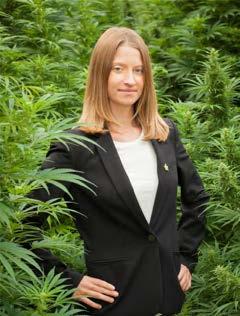
Championing Legal Policy for U.S. Hemp Agribusiness Courtney N. Moran, LL.M. Founding Principal “THE Hemp LAWYER” ~Oregon Leaf Magazine 541-632-3946 | info@earthlawllc.com










Nanoshell Company NANOTECHNOLOGY INSPIRED BY INNOVATION CBD with Intelligent NanoDelivery TM Salt Lake City , UT www.nanoshellcompany.com
Mechanized Drying
 By Becky Long
By Becky Long
Now that growers have relearned how to grow and harvest industrial hemp, the next hurdle is processing and infrastructure. The first line of defense against losing the entire crop is quick, efficient and effective drying. Climate and humidity levels have a huge impact on barn-drying capacities. Even with optimal atmospheric conditions, many hemp growers will need to consider mechanized drying due to their acreage.
What are the considerations for drying hemp? The first question is “What part of the plant?” Drying the flower for CBD production is significantly different than drying the seeds, straw, fiber or hurd. The flower is extremely delicate, and the oils can be damaged by heat, whereas the straw and/or hurd can be dried similarly to wood chips or shavings.
Safety: As hemp is organic, meaning carbon-based, and has a similar BTU (British Thermal Unit, a measure of heat energy) content to wood, it should be considered a fuel and combustible. Growers should proceed with caution.
Surface and/or bound moisture: Hemp has potential for both. Bound moisture is far more difficult to evaporate, as the dryer must not flash the surface dry but needs to gradually warm the whole particle and drive moisture from the inside out.
Susceptibility to radiant energy: Yes, as an organic material, any portion of the hemp plant is susceptible to getting a “sunburn,” so care should be taken to reduce the presence of a visible flame.
Energy usage: Is natural gas or propane available? Drying requires a lot of energy. Many factors need to be includ-
ed in the calculation to determine how much energy is required. The bare minimum is 970 BTU to evaporate a pound of water, but that is only if the water is already at 212 degrees Fahrenheit. That doesn’t include warming the water to that point, along with the associated solids, ambient air, fuel, system, etc. A reasonable estimate for evaporating a pound of water is between 1300 - 1800 BTU if utilizing recirculated drying gases. It is crucial to know the moisture content of your yields to determine the required energy for drying. If
38 LetsTalkHemp.com
you harvest 2 tons/acre at 50% moisture, you need to be able to evaporate 1 ton of water/acre. A quick estimated energy usage is 1300-Btu/lb times 2000-lb/ acre = 2,600,000-BTU/acre or 2.6-MMBtu/acre to 1800-Btu/lb times 2000-lb/acre = 3,600,000-Btu/acre or 3.6-MMBtu/acre. For reference, the small, easily exchangeable 5-gallon (20-lb) propane container holds roughly 110,000-BTU. At the bare minimum, you’d be looking at 24 - 33 of those, so, not a practical solution. A grower can save a significant amount of energy by only drying the flower and not the straw, if applicable.
Food-grade equipment is typically stainless steel. Carbon steel should be sufficient only when drying stalks for energy or bedding. Care must be taken with carbon steel, as it can be eaten away by corrosive environments. The high water content of the drying gases will occasionally create a corrosive environment, even in the absence of a corrosive product.
Conveyance: Any portion of the hemp plant has a relatively low density and is capable of being pneumat-
ically or mechanically conveyed. Pneumatic drying options include high-flow, rotary-drum dryers, fluid-bed dryers and flash dryers. Mechanical conveying options include low-flow, rotary-drum dryers, belt dryers, tray dryers, etc. All mechanized dryer types perform best with uniform material; some function very poorly, or not at all, without uniform material.
Of the “Big Four” styles of continuous, mechanized dryers that have the highest hourly capacity, a low-density, uniform product is a candidate for being dried in a rotary-drum dryer, on a belt or tray dryer, fluid bed or flash dryer. If the product is not uniform, the best option is a high-flow, rotary-drum dryer, where the lighter, drier pieces have the opportunity to exit the drum before heavier, wetter pieces. This prevents the lighter pieces from getting singed or burned and allows heavier pieces to remain in the drum longer to fully dry.

Hemping While Hemping While
children on his 5,000 acre farm, where they reportedly grew massive amounts of hemp as early as 1774.
Intro by Cait Curley
Hemp wouldn’t have thrived in early America without farmers exploiting slaves for labor. Period. June 6-13. 2020 was officially Hemp Week, previously known as Hemp History Week until its rebranding this year, so let’s get to the point and dig into the shameful truth of slavery in America and its relation to hemp history. It’s a fact that the concentration of slavery was in the hemp producing areas. Slaveholders like George Washington and Thomas Jefferson lined their pockets with money made from hemp produced by slaves. Rewind to 1619 in Virginia, it was illegal to not grow hemp! Soon after, due to its resourcefulness, other states adopted similar laws. Cultivation predominantly remained in the South, where slaves were forced to plant, harvest and process hemp.
Enslaved workers were tasked with dirty and labor-intensive jobs of breaking the stalks and hackling hemp fiber, as well as working in manufacturing establishments where they made hemp bales and rope by hand in long, narrow buildings called rope walks. They were under immense pressure to meet daily harvesting quotas.
Thomas Jefferson forced slaves to cultivate hemp on his plantation called Monticello in Virginia, where tobacco, cotton, flax and other mixed crops also grew. He enslaved men, women and
The widespread success wouldn’t last long as hemp production began to decline during the Civil War and following the abolition of slavery. After the South fell, Kentucky became the only state with a relevant hemp industry. It relied on scamming newly freed black people with sharecropping. As more and more black people escaped the oppressive reigns of sharecropping agreements, the hemp industry continued to struggle to industrialize.
“Hemp… is abundantly productive and will grow for ever on the same spot, but the breaking and beating it, which has always been done by hand, is so slow, so laborious, and so much complained of by our laborers.” – Thomas Jefferson, 1815
By Ronit Pinto and Jaime Lubin
We are aware of this country’s sordid present and past, but we want to focus on the positive. Beautiful human beings from across the globe, claiming what is theirs. We are, after all, in the middle of a revolution. Black Lives Matter for the books. Allow us to introduce you to a few thriving hemp entrepreneurs who are making hemp history every day. Business people and healers Honeysuckle has been fortunate to meet, chronicle, and collaborate with through the years.

40 LetsTalkHemp.com
While Black While Black
Be rooted in their wisdom, but remember that representation is always key. Seek out others in the industry who are doing just as much to spark change and enhance visibility. Black business owners are active and rising in hemp.
C.K. Dunson is the founder of The Garden District, a family of lifestyle and wellness brands that includes Bouqé, a line of hemp rolling papers. Committed to grassroots efforts and sparking change from within local communities, CK shares his insights on what it takes to “Roll the Revolution” and why the Washington D.C./Maryland metro area is a truly uplifting place to feel the power of the plant.
HONEYSUCKLE MAGAZINE: What made you interested in becoming a hemp entrepreneur? What do you love most about your business?
C.K. DUNSON: It was a combination of things that led me to becoming a hemp entrepreneur. I first became interested in hemp after learning about its vast history and how versatile the crop is (it can produce paper, concrete,beauty products, textile goods, medicine…etc.); on top of that, the crop can have a positive impact on the environment if cultivated properly. Secondly, I wanted to become involved with the cannabis industry, so producing papers made out of hemp was a natural progression.
What I love most about our business is that we really get to touch the people and influence the culture through our grassroots efforts, (that’s how we were introduced to Honeysuckle.) Those personal connections have al-
lowed us the privilege of collaborating with up and coming artists/creatives. I also love the community-building aspect of our business; seeing it grow from scratch is truly amazing and gives such a rewarding feeling. The feedback from our community gives us the added motivation to keep grinding and develop our business further.
How did you get inspired to create a line of hemp rolling papers? Your tagline "Roll the Revolution" is especially fitting right now - what does it mean to you?
The impetus to create the brand Bouqé came from the desire to be a part of the cannabis industry. After facing rejection from more established businesses in the industry, I set out to do my own thing. I wanted to prove that you don’t have to start off with millions of dollars, and connections to make it in this industry. But with a strong vision and ingenuity mixed with the right hustle, you can create your own lane and build a brand that can truly compete in the marketplace. Additionally, I’m a brand guy, I like what they represent and the cultural impact that they carry. So given that, I wanted to build a brand of my own that represents the culture. Our tagline “Roll the Revolution” seemed so fitting since our goal is to help destigmitize the cannabis industry and disprove all of the negative stereotypes that exist to describe cannabis users, especially users of color. With all of the turmoil we seem to be experiencing right now, our motto is a little bit of a double entendre — Bouqé is for the cannabis enthusiast who handles their business and likes to roll up while doing it. We represent the people who are bold enough to fight

LetsTalkHemp.com 41
for the change they want to see in the world, whether those changes are societal, medical, or environmental.
How has COVID-19 affected Bouqé and The Garden District, and what are your longer-term goals for the businesses?
COVID has definitely been an interesting time. Looking back on the past few months, I'd say our team has responded well to the challenges that COVID has presented. It has revealed to us some of our strongest assets to be our ability to innovate as well as the strength of our community. Even in these trying times, business has continued to grow, which says a lot. Hopefully this momentum will help us double down on our efforts to build a full 360 hemp business that touches many aspects of one’s day to day lives.
What opportunities does hemp offer for Black entrepreneurs and the larger Black community? Conversely, what are the greatest obstacles?
Hemp offers Black entrepreneurs a chance to get in on the ground floor and become stakeholders of a new industry in various ways. The economic opportunity that has the potential to positively impact generations,

and provide people with the ability to create generational wealth but when there's significant earnings to be made, there are always hurdles you have to overcome. For example, the research about the plant still being in its infancy stage and ambiguity in hemp and cannabis policies from the government are barriers that see no color and impact everyone. But for black people specifically, I think access, whether it's to funding, information or other resources are the biggest threats that inhibit us from making progress in this industry.
We've noted, as have so many in the community, that the hemp industry has even greater problems with racial disparity and social equity than cannabis does. How do you think the hemp industry should confront its hypocrisy when discussing "social equity"? How do we bring more Black representation across the board? In order to create real social equity in the hemp industry, I think general education about the plant and industry can be extremely beneficial. The funding of nonprofits/ organizations in our community whose missions are to educate and teach our community how to succeed in this industry like Uplift Maryland and Marijuana Matters DC. Additionally I think there should be some regulation that designates a certain percentage of funding and business loans to black-owned businesses, a certain amount of acreage is designated to black manufacturers and so on.
What advice do you have for people looking to get into the industry?
Get outside and get involved with your community/industry. Networking has a lot of value.
This lyric I wrote pretty much sums it up:
“In the game when you hustle/ You get bruised, you’re going to fall/ But in the game you got to hustle/ if you want to scoop the loose ball.”
Other advice I'd give to people looking to get into the industry is to collaborate with other brands in your space that have an aligned vision and build or find a team to be a part of.
While I’m here I wanted to give a big S/O to the Bouqé team as well as S/O some businesses that we have been able to build with:
Marijuana Matters DC
Nubian Hueman
Olot Photography
Grade A Designs
Eternal Designs
Mary & Maine
Uplift Maryland
Floydworld
Soul Squad
Tanganyika’s journey with cannabis and hemp have taken her all over the world. A Marine Corps veter an and founder of Jayn Green, a skincare and beauty brand, she has forged a dynamic path in advocacy and education. She is the first chairwoman of the Georgia Cannabis Coalition, which works to offer insights and opportunities for the legal industry to Georgia-based entrepreneurs, and has consulted for numerous companies in the sector including the veteran-run Warfighter Hemp. She explains in exquisite detail why the historic opportunity of hemp is a once-ina-lifetime chance for many in the Black community.
HONEYSUCKLE MAGAZINE: What made you interested in becoming a hemp entrepreneur?

TANGANYIKA: Well, I love all things cannabis, not just necessarily marijuana or hemp, but I love study ing the dynamic aspects of the entire plant or the entire species. So as I started to learn more and more about marijuana and the restrictions around it, the licensing structure and how states were setting up their programs, I started to look for alternative ways to get into the in

dustry that didn't have so much overhead, but had more longevity as well. And when I started to do more research, hemp has more longevity in the future with over a hundred thousand uses. It also has the potential to disrupt so many industries. So you know that it's going to be around for a very, very long time. Those are the reasons that I started to look into hemp, and I really enjoy the fact that it is such a versatile plant, that it doesn't take that much to grow or sustain it, and that it grows quicker than trees; the amount of crops that you can have per year are more. So I just think that this plant is truly amazing.
What do you love most about your business?
What I love about my company or my business is that I've been able to adapt and pivot several times in the industry and gain more and more insight, more people, expand my network and really just stick around when other businesses have had to shut down. That's such a blessing to me because I have seen in the beginning how this could go and what could go wrong and I've been able to thrive and survive. That's something that I really love about Jayn Green and the fact that it's come full circle. It started as a skincare line, and now we're back in the hemp beauty space and it's now offering more CBD beauty products. And that's what I love about my Jayn Green; [it’s] able to adapt to all circumstances in any environment when it comes to the cannabis industry and hemp industry offer so many possibilities to the black community.
What opportunities does hemp offer for Black entrepreneurs and the larger Black community?
We have not been able to get in on the ground floor of any major industry for the last 400 years. So it's very important that we not only get in on the ground floor of cannabis, but we're able to create systems and create infrastructure so that we can be around for the long haul. Think when prohibition was ending with alcohol, think of the Anheuser-Busch and think of the Miller Lites and all of those companies that are still around today because they were able to get started in the beginning. With hemp, you can do transportation as a really big industry that I think the Black community could really dominate in logistics. Thinking about hemp or hemp condoms or hemp clothing lines... The culture moves everything. And so if we are able to carve our niche out in this industry, without it being restricted and without it being such a financial burden to get involved in, we
could really see our potential grow and we can see us being involved in this over the next hundred-plus years.
Conversely, what are the obstacles for Black entrepreneurs in the industry?
This is a really lucrative business opportunity for us. What's so bad about the situation is that not many black people know about the benefits of cannabis in general, let alone the financial opportunities that are involved in getting in the industry. A lot of people are unfamiliar with that. The fact that it's legal federally and that

44 LetsTalkHemp.com
you can get loans and grants and subsidies, that you can get crop insurance on it, that you can subsidize your crops with. There's so many opportunities in the 2018 Farm Bill that people are just not aware of. That's one of the obstacles. Another obstacle that we face is that we're not real landowners and it's a farm. [With hemp] you need land to grow. We are an agricultural community by nature, but we've been distanced from that because of segregation because of systematic oppression because of our land being stolen, etcetera. So now it's time to get back to ownership. Now it's time to get back to allowing us to have land. We want to have liquid assets. We want these things to be able to be given to us because we deserve it. And we're owed it after all of the years of... the free labor that we've given to the country.
How do you think the hemp industry should confront its hypocrisy when discussing "social equity"? How do we bring more Black representation across the board?
One of the ways that the hemp industry can move past this hypocrisy is by three things. It's by licensing land and liquid assets. The African-American/ Black community should be given half of all licenses of every state, period. No questions asked. As long as you qualify, you should be able to get a license. Because we want to make sure, again, that the industry is equitable. Also land. We deserve land. The Black community deserves to have the land that was stolen from them, the 40 acres that were promised to them. Now is the time to deliver on those promises.
So if we were able to get the land and grow our own crops, sourcing our own genetics, creating our own nutrients, creating our own distribution network with transportation and logistics - These are opportunities that we can absolutely dominate, and we can be a part of for the long haul and grow as the industry continues to grow. It’s still in its infancy phase. This is how we can strategically get involved and be a part of this industry. Once we acquire the licensing and the land, we are owed liquid assets. We are owed monetary restitution for the lies that were told in the War on Drugs for the actual targeting of our community, for the families that are disrupted, for the lives that have been lost, for the education that has not been gained, for So if we were able to get the land and grow our own crops, sourcing our own genetics, creating our own nutrients, creating our own distribution network with
transportation and logistics - These are opportunities that we can absolutely dominate, and we can be a part of for the long haul and grow as the industry continues to grow. It’s still in its infancy phase. This is how we can strategically get involved and be a part of this industry. Once we acquire the licensing and the land, we are owed liquid assets. We are owed monetary restitution for the lies that were told in the War on Drugs for the actual targeting of our community, for the families that are disrupted, for the lives that have been lost, for the education that has not been gained, for the problems that are caused when it comes to housing. All of these things need to be accounted for. And restitution is also owed to the Black community. We now know the truth is undeniable: Systematic oppression and racism lead to all of these problems... When our founding fathers grew hemp, we should have always been allowed to keep those resources in this country. Instead, we outsourced it to China and imported it from other countries. And we lost that revenue. We lost those jobs. Now is the time to get restitution for all of these issues that were caused by those lies that were told by greedy politicians who were racist and in a position of power to create a disruption in communities that they didn't like.
What advice do you have for people looking to get into the industry?
The advice that I would give to people and trying to get into the cannabis industry is research where you are right now. If you have any skills that you can transfer over into the industry, we absolutely welcome it. And that's absolutely any skills. I'm talking to my movie writers, tech people, software developers. We’re talking about HR, we're talking about accounting, we're talking about engineering. Anything that you can do out in the outside world or that you built in a regular job, you can bring those skills over to the cannabis industry and especially in hemp, because hemp is so brand-new [that] we're reintroducing [it] back into our economy and back to our country.
And I would say, don't be afraid to move. Don't be afraid to relocate. If the opportunities are better elsewhere, if the entry is lower, if you are able to afford land, if opportunities present themselves, don't be afraid to take advantage of them and see what the future holds for you. This is an amazing opportuni-
LetsTalkHemp.com 45
ty, and we won't get this again for another 200 years. So please take advantage and do your research now. And if you need help, we're always here to assist you.
Ewket Assefa is the founder of Elevated Naturally, a wellness brand of handcrafted, sustainably-sourced herbal remedies including many hemp-based products. Hailing from Ethiopia, Ewket relocated to the United States after college and is now based in Boulder, Colorado. She brings a deep sense of spirituality and family history to her work, having learned herbal healing from her grandmother, a renowned practitioner of spagyric techniques and expert in medicinal plants.
HONEYSUCKLE MAGAZINE: What made you interested in becoming a hemp entrepreneur?
EWKET ASSEFA: It has been a passion of mine to work with medicinal plants and share their healing powers with others. Growing up in Ethiopia where plant medicine and localized agriculture are an inherent part of the culture, I was also influenced by my grandmother who was an herbal healer. My herbal practice is not limited only to Hemp, but other healing herbs as well.
What do you love most about your business?
I love working with plants and the natural environment. I love crafting personalized herbal healing remedies and seeing other benefits from it.
There is a tremendous legacy of pan-African culture and relationship to the Earth through agriculture. How do you express that in your work? What should we understand about Ethiopian traditions and use of hemp?

Western science depends on written documentation; many of the ancient traditions passed orally were ignored. I honor my ancestors' legacy and sacrifices, by reconnecting to the traditions they fought to keep. My work expresses the ancient alchemically-enhanced plant extractions called SPAGYRIC which offers a more energetically complete herbal extraction that contains the three essentials: the body, soul and spirit of the herb. The spagyric technique is part of
Growing up in an Ethiopian traditional family, our garden was full of medicinal plants. It was common practice for many Ethiopian families to grow and to make their own homemade herbal remedies. Regarding Hemp (Cannabis) in Ethiopia, it was a sacred herb administered by healers; also the monks in Ethiopian coptic monastery use it when they go through their lifetime study of religion.
I recently learned that my own grandmother, who
46 LetsTalkHemp.com
the ancient Ancient Egyptian method of extraction.
was an herbal healer, had grown Hemp (cannabis) among other herbs in her garden. Cannabis was not divided into hemp or marijuana, it was just one plant known as Atafarese. In contrast the American culture of cannabis largely has evolved from recreational use and recently moving into medicinal uses. One of my goals at Elevated Naturally is help support the understanding of medicinal plants including cannabis.

Your grandmother played a large role in your early understanding of plant medicine. How does that family history influence you now?
I feel that I am not working alone; I am working with my ancestors. I have their protection and guidance… My grandmother helped people in her house for free. She always said, ‘What I do, I’m doing it for you. For my grandchildren.’ Doing this for people, it is not really for money. I talk to my ancestors and thank them for healing. When I work with my plants, I have all this energy that I’m working with. You use the astro-
logical calendar, the new moon, the Earth and nature.
You’ve said that your experience, as an Ethiopian citizen emigrating to the United States, is very different from most Black Americans in that you didn’t experience racism until you moved here. What are your thoughts now on systemic racism in this country?
We [Ethiopians] come from a country that has never been colonized. Ethiopians don’t see themselves as less than any other. It is a proud nation… There is not much I can say that I have been discriminated against… Ethiopia never accepted colonization or slavery… I don’t have the same observation as those that are African American born (whom their family brought to the U.S. as slaves). I came to the US to attend college and I didn’t know what racism meant before coming to the U.S [Watching the protests now] makes me think America is really backward in that sense. [Yet] they call African people, who are living a natural life, backward.
Do you feel the hemp industry lacks representation for Black entrepreneurs?

It is still a mystery to me why we do not see Black people in the hemp industry… I’ve only met maybe two Black people who are involved in the industry, but I don’t know the reason why [there are so few]. When I am at my booth at an expo, people pass by and ask me, ‘Is this your business? Is this your booth or are you just working here?’ They ask me that so often and I don’t see them ask other owners the same thing.
[Regarding the American hemp industry generally], we haven’t proved that we are successful in hemp and cannabis in this country the way we use it. In other countries, the way they use it [is more well-rounded]... There’s a worry the cannabis plant may not have medicinal value in the future. It’s like Monsanto - all big companies.
What advice do you have for people looking to get into the industry?
There is a lot of misleading information about the hemp industry and I would advise people to study it well before jumping to it. We can clearly see the falling of the cannabinoid market. The U.S. seems way far from producing Industrial-scale hemp (clothing, building material so on). Most of the industrial hemp we can find in the US today comes from China and India.
I would like to see humility in the industry and people to learn the historical and cultural uses of cannabis as it has been for thousands of years instead of acting like an expert in this new industry to the U.S. As in any other industry, the U.S. hemp/cannabis industry is exploiting poor countries for cheaper labor and land. My fear is that those companies are polluting and pollinating the indigenous medical plants that have been there for thousands of years and are acclimated to their region. Unfortunately, the recent cannabis dialogue has been shaped by elite privilege and reflects the partial perspectives of privileged viewers, race and class. Understanding of cannabis history would improve how mankind can manage it today.



F UP FOR IT
By Darwin Millard
Fit-for-Purpose is a novel concept that promotes the notion that regulations for the cannabis plant, its parts, products, and processes should be designed with the intended use or purpose in mind rather than a set of attributes that vary from jurisdiction to jurisdiction. It is complicated enough for regulators to think about the cannabis plant without having to worry about whether that cannabis plant can be classified as “hemp”. Fit-for-Purpose simplifies this debate.
The concept is straightforward; regulate the cannabis plant in the context of its uses, flowers, resins, seeds, seed oils, protein powders, dietary fibers, textile fibers, technical fibers, construction materials, biofuels, etc., instead of its cannabinoid content.

Shifting the paradigm from the “cannabinoid content” to the “intended use/purpose” for which the cannabis plant is being grown or the product is being manufactured allows for more commonsense legislative frameworks to be developed, promoting commerce, mitigating confusion and easing regulatory burden.
The benefit of using a “fit-for-purpose” approach to thinking about the cannabis plant, its parts, products and processes is that it eliminates the need
to think about the molecular constituents, allowing the conversation to focus on the intended use.
So how does “fit-for-purpose” work?
The Fit-for-Purpose concept is used like a classification system to define what regulations to apply based on the intended use. This classification system establishes six distinct usage categories/applications for the cannabis plant, its parts, products and processes which can serve to help guide the development of industry standards and best practices.
These categories include:
Adult-use—any application associated with the production of edible or non-edible products containing the flowers and/or resins of a cannabis plant.
Medicinal—any therapeutic application associated with the production of edible or non-edible products containing the flowers and/or resins of a cannabis plant.
Food—any application associated with the production of edible products from a cannabis plant, except those explicitly associated with adult-use or medicinal-use. It should be noted that food applications do not limit the inclusion of the flowers and/or resins, as long as these are naturally occurring constituents of the
50 LetsTalkHemp.com
material being used to manufacture the food product and were not previously separated prior to inclusion.
Topical/Dermal and Mucosal—any application associated with the production of non-edible health and beauty products from a cannabis plant. Topical/dermal and mucosal products containing flowers and/or resins should be subcategorized into adult-use or medicinal-use.
Propagation—any application associated with the planting/breeding of a cannabis plant either through seed, clone/cutting, tissue culture or other means.
Industrial—any application of a cannabis plant, its parts, or products not associated with adult-use, medicinal, food, topical/dermal and mucosal or propagation purposes.
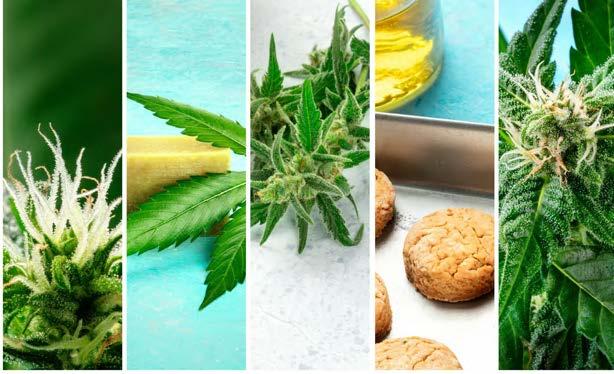
These usage categories provide clearly delineated lanes for the development of commonsense regulations based on the application, type of product and intended marketplace.
Given that the cannabis plant can be grown for a myriad of different applications when cultivating or manufacturing for multiple purposes, the regulations applied should be based on the quality and safety associated with the most stringent “purpose” and/or “use”. For example, cannabis plants grown for seed and stalk, when the seeds are intended to be eaten, should be cultivated under Good Agricultural Practices (i.e. according to food standards); whereas, cannabis plants
grown only for stalk may solely require some form of environmental stewardship rather than a food standard.
The same idea can be applied to processing the raw materials derived from the cannabis plant. For instance, when processing the flowers to separate the seeds for food production and the remaining chaff for phytocannabinoid extraction, the processing of the flowers should be conducted under Current Good Manufacturing Practices. Those manufacturing practices are then further defined by the intended marketplace for the phytocannabinoids, whether that be foods, natural health products, adultuse products, medicaments, or any combination thereof.
Through the implementation of a “fit-for-purpose” classification system, operators and regulators alike will be able to more easily define the intended use of a cannabis plant, its parts and products, the subsequent regulatory pathway they need to pursue to remain in compliance with the authority having jurisdiction and maximize commercialization. By providing a straight line from product type and intended use to the applicable regulatory framework, Fit-for-Purpose removes any ambiguity about how to cultivate, harvest, process, and/or handle the cannabis plant and associated products while promoting consumer and environmental health and safety.
Fit-for-purpose challenges the confines of the current draconian bifurcation of the cannabis plant and begs
LetsTalkHemp.com 51 ESOPR
the question: Is the world ready for this novel concept?
Darwin Millard is Co-Founder and Partner of Millard Masonek Solutions, also known as Phytologix. He has presented this proposal as Subcommittee ViceChair, ASTM (American Society for Testing and Materials) International – D37.04 on Cannabis Processing and Handling and Subcommittee Co-Chair, ASTM International – D37.07 on Industrial Hemp.
Food—any application associated with the production of edible products from a cannabis plant, except those explicitly associated with adult-use or medicinal-use. It should be noted that food applications do not limit the inclusion of the flowers and/or resins, as long as these are naturally occurring constituents of the material being used to manufacture the food product and were not previously separated prior to inclusion.
Topical/Dermal and Mucosal—any application associated with the production of non-edible health and beauty products from a cannabis plant. Topical/dermal and mucosal products containing flowers and/or resins should be subcategorized into adult-use or medicinal-use.
Propagation—any application associated with the planting/breeding of a cannabis plant either through seed, clone/cutting, tissue culture or other means.
Industrial—any application of a cannabis plant, its parts, or products not associated with adult-use, medicinal, food, topical/dermal and mucosal or propagation purposes.
These usage categories provide clearly delineated lanes for the development of commonsense regulations based on the application, type of product and intended marketplace.
Given that the cannabis plant can be grown for a myriad of different applications when cultivating or manufacturing for multiple purposes, the regulations applied should be based on the quality and safety associated with the most stringent “purpose” and/or “use”. For example, cannabis plants grown for seed and stalk, when the seeds are intended to be eaten, should be cultivated under Good Agricultural Practices (i.e. according to food standards); whereas, cannabis plants grown only for stalk may solely require some form of environmental stewardship rather than a food standard.
The same idea can be applied to processing the raw materials derived from the cannabis plant. For instance, when processing the flowers to separate the seeds for food production and the remaining chaff for phytocannabinoid extraction, the processing of the flowers should be conducted under Current Good Manufacturing Practices.
Those manufacturing practices are then further defined by the intended marketplace for the phytocannabinoids, whether that be foods, natural health products, adultuse products, medicaments, or any combination thereof.
Through the implementation of a “fit-for-purpose” classification system, operators and regulators alike will be able to more easily define the intended use of a cannabis plant, its parts and products, the subsequent regulatory pathway they need to pursue to remain in compliance with the authority having jurisdiction and maximize commercialization. By providing a straight line from product type and intended use to the applicable regulatory framework, Fit-for-Purpose removes any ambiguity about how to cultivate, harvest, process, and/or handle the cannabis plant and associated products while promoting consumer and environmental health and safety.

Fit-for-purpose challenges the confines of the current draconian bifurcation of the cannabis plant and begs the question: Is the world ready for this novel concept?
Darwin Millard is Co-Founder and Partner of Millard Masonek Solutions, also known as Phytologix. He has presented this proposal as Subcommittee Vice-Chair, ASTM (American Society for Testing and Materials) International – D37.04 on Cannabis Processing and Handling and Subcommittee Co-Chair, ASTM International – D37.07 on Industrial Hemp.
52 LetsTalkHemp.com
--
Land of the free
By Melissa Peterson
“Now is the time to band together and hold people accountable and require them to be human.”
- David Newsom
“For those of us with husbands or sons of color, we have had to have very different, difficult conversations about how to behave when pulled over for dirty license plates (this happens regularly). Or to remind our teenage boys that they cannot condone bad behavior when with their white friends act the same way in public places. These are scary times, but the reality of being other colored in this country has been part of my family’s dialogue for a long time. I’m proud of the brown, yellow, red, black and white people who have come together to say enough is enough. Our industry has been standing up to agencies and government officials to change our world. We have worked hard to have a voice, let’s use it to make sure that the world is a better place for EVERYONE, all of our sons and daughters, no matter the color of their skin.
- Hunter Buffington
As the saying goes, we are the “land of the free and the home of the brave.”
If we have learned anything in 2020, it has been to question the simple values of America. As a country, we have been shackled, lied to and brought to our knees, begging for answers on how to keep our families safe.
The “land of the free”? We claim to be the land of the free because our citizens are free to do as they wish. At first glance, we are free. We have so many advan-
tages other countries do not. People leave their homes and flee to the “Great America” for a better life. Yet here we are, fighting in the streets, like a third world country, to protect the rights of American citizens that should not need protection. The thought that anyone would be treated differently because of their color is not only heartbreaking — it is horrifying.
What are the answers to end this madness? How is it that the people in our industry have come together (no matter their color) to fight for the right to grow a crop that was once used to clothe the soldiers fighting for those rights and freedoms?
We are not asking — we are demanding the people in our industry stand up again, just like we did when we were fighting for the right to grow hemp. We need to be heard now more than ever before. We need to pound our fists harder and louder for the American people of color to be protected from the very people that are paid to protect us.
The “home of the brave”? We are the home of the brave because we feel Americans are courageous. So, be brave and courageous, be a real American hero and demand equality for all.

Stand up to your government! Do not ask for a conversation. Demand an open dialogue with government officials to ensure they understand the dire need for a resolution to the inequality that has been going on way too long with too little change! We cannot allow this to continue.
Step outside of your comfort zone, open your heart and find a way to understand what those police officers did to another human being. Pick up a sign for a tired protester and carry their voice to the end. Walk the walk!
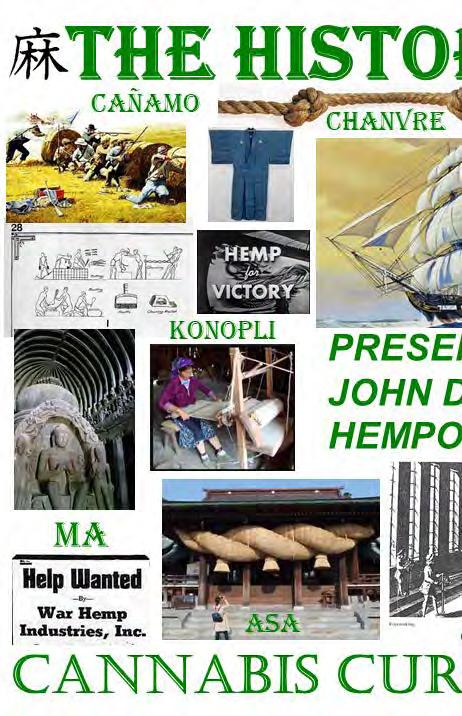
54 LetsTalkHemp.com

LetsTalkHemp.com 55

56 LetsTalkHemp.com
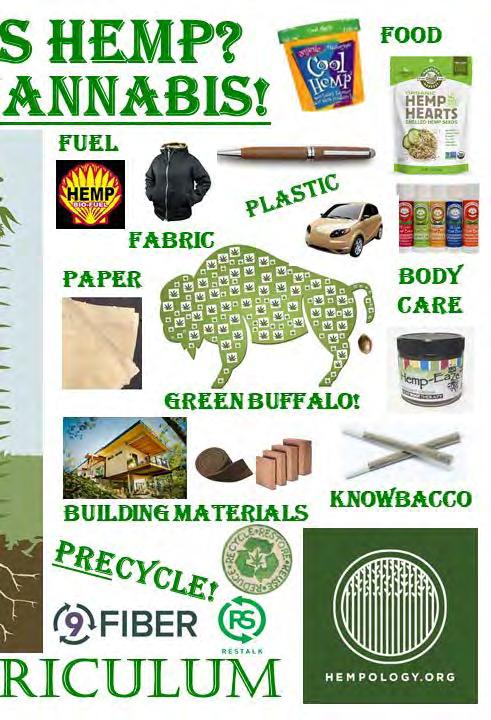
LetsTalkHemp.com 57
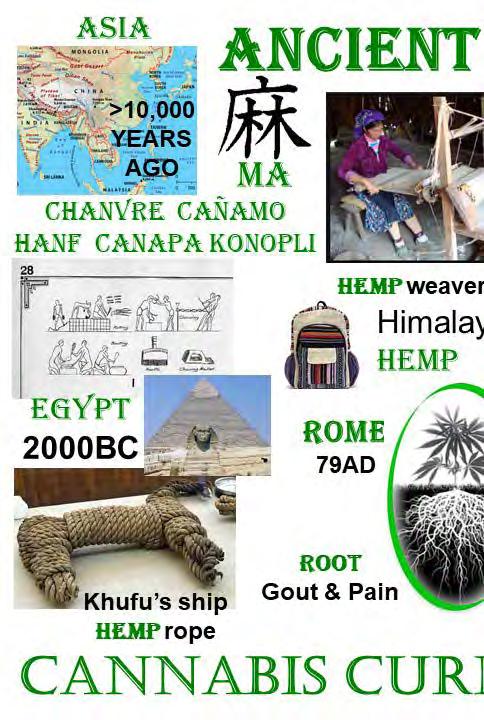
58 LetsTalkHemp.com

LetsTalkHemp.com 59

60 LetsTalkHemp.com
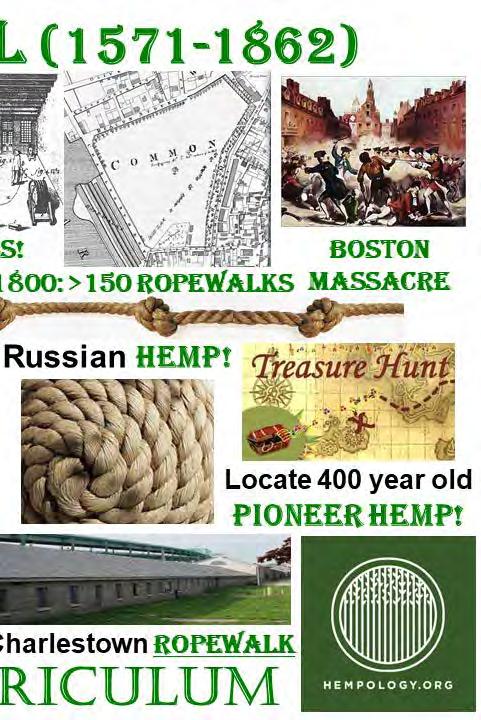
LetsTalkHemp.com 61

62 LetsTalkHemp.com

LetsTalkHemp.com 63

64 LetsTalkHemp.com
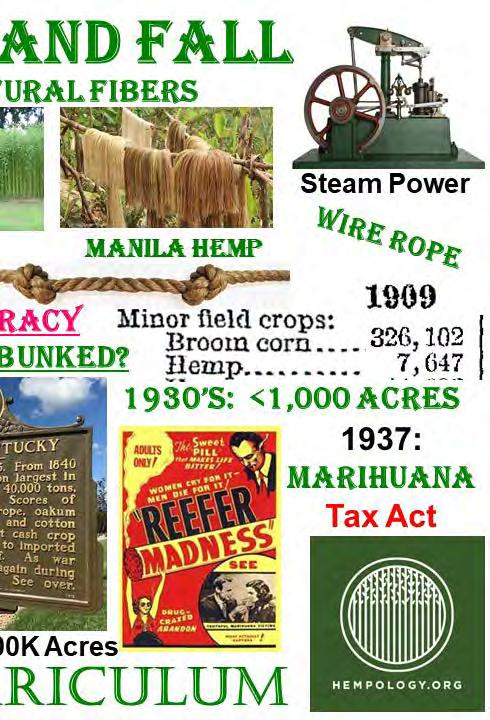
LetsTalkHemp.com 65
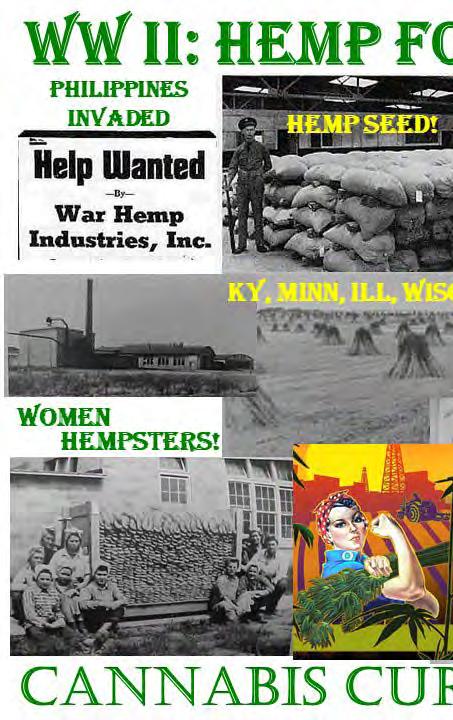
66 LetsTalkHemp.com

LetsTalkHemp.com 67

68 LetsTalkHemp.com

LetsTalkHemp.com 69
Value Added Through Nano technology

resents the true value added for CBD product makers.
By Agnes Ostafin, PhD
Nanoshell Company, LLC Salt Lake City Utah
Even before the CBD industry hits its peak stride, people are already looking toward the next generation of CBD-based products to differentiate themselves and be most competitive. With the price point of raw material declining rapidly as new players enter the game, the pressure to do so is strong.
Many people would like you to think that there is a one-size-fits-all nano-CBD formulation that works in every product the same way. This is false. The way you nanosize CBD, or any active, for that matter, depends on where it is intended to act (e.g. internally, on the skin, as an aerosol, et.c), what it is going to be mixed with (e.g. water, salts, oils, proteins, sugars, surfactants, etc.) and the processing conditions used to make the blend (e.g. heat, high shear, etc.). All of these conditions will affect the durability, blendability and stability of the nanosized active and ultimately its effectiveness. The same recipe handled wrong won’t work the same as one that is handled correctly. The same recipe put in a fruit juice won’t work the same in a cream.
One approach being pushed by many is to add value by utilizing nanotechnology. Nanosizing CBD means creating tiny droplets of CBD, containing hundreds, even thousands, of CBD molecules and holding them in suspension. The prevailing wisdom is that these small packages enhance the bioavailability of the CBD, making a little go a long way. Nano is not a thing or creature by itself, and just because something happens to be nanosized does not make it necessarily bad or good, dangerous or safe. Nano is, in fact, natural. Microbes, plants and trees produce nanosized byproducts when they grow. The human cell is a bag containing thousands of nanosized organelles that do specific things to keep the cell, and the organism it belongs to, alive. Nano has been part of the human world right from the beginning of its existence.
Nanomaterials, natural or engineered, vary by size, shape, charge, elemental composition and surroundings. These factors determine what its properties will be and where it can be most effectively used. Medical doctors are using biomimetic, engineered nanoliposomes and nanoemulsions that are safe and effective for the purposes of delivering medicine, imaging and measuring things inside living things. The correct combination of ingredients provides stability in a wide variety of environments, selective permeation, low immunogenicity, targeting and other important features. A correctly designed capsule allows the use of less active for the same or better, response-reducing waste. This lowers the chance of adverse reactions in sensitive individuals. This type of nanosizing rep-
Choosing someone to help you navigate the potential of value-addition through nanotechnology is not an easy task. First, don’t be fooled by nanoCBD processors that provide a one-size-fits-all approach. Make sure they are asking questions about your product and how it will be handled so that they can make the best fit between their nanosizing method and your needs. Second, make sure they know something more about enhanced bioavailability, that “it’s just more.” If it is a dietary supplement, your nanodesigner should know something about basic intestinal physiology and digestion of foods and understand how nanoCBD will integrate with what normally goes on in your body when you eat nutrients. Third, and perhaps most important, avoid processors that exclusively claim “the smaller, the better.” This is false and potentially dangerous. While smaller things penetrate solid material more quickly, your body is much more complicated than a simple solid surface. Nanosizing allows you to bypass the digestive system in favor of buccal, or mouth, mucous membrane absorption. This is responsible for the “fast” effectiveness people report when using nanoCBD products. While fast relief for what is ailing you is generally a good thing, it is also has the potential for overdosing the brain (which isn’t very far away, after all) and losing its effectiveness because many actives, including CBD, need the signaling molecules provided by the digestive system to package themselves into a form that cells in your body can assimilate. While the CBD penetrates the cells in your brain via a different mechanism that does not need those signals, that por-

tion of the CBD that you would want to penetrate cells in your joints and muscles won’t be recognized without the proper packaging molecules. If the formulator is not adding those signaling molecules during manufacturing, then you have to rely on your body to provide them. If your body can’t do that, then you are, again, wasting material and raising the risk of exposing yourself to too much CBD in the effort to find an effective dosage.

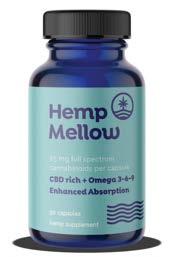


So, if you think adding value to your CBD through nanotechnology is for you, ask a lot of questions. If the answers don’t seem right, they probably are not. Trust your instincts. Happy CBD-ing!

GOOD FOR YOU INGREDIENTS MADE FROM ONE MIGHTY SEED.

72 LetsTalkHemp.com
TM www.hempmellow.com @hempmellow Make Life A Breeze. Featuring enhanced bioavailability with Nature’s Delivery SystemTM
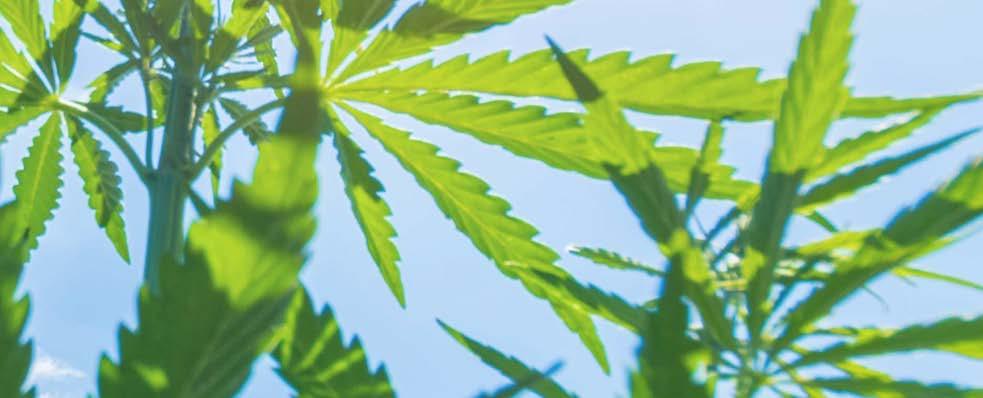





LetsTalkHemp.com 73 Incubator Accelerator CoWoRK Take Our Survey! www.cannabiziac.com @cannabiziaccontact@cannabiziac.com561.651.9565 Grow your CannaBIZ! Apparel | Arts & Books | Gifts & Novelties | Advocacy | And More cannurban.com Peacefully protesting prohibition. Get your swag!
Hemp Batterty?
By Jean Lotus
Industrial hemp has shown promise as a potential ingredient in super batteries that might allow your phone or electric vehicle to charge faster in the future. However, getting a hemp battery to market is taking a long time.
Hemp, a cousin of marijuana, was illegal to grow for 80 years in the United States until the passage of the 2018 Farm Bill. It’s been almost seven years since a group, led by Clarkson University engineering professor David Mitlin, presented an article published in American Chemical Society’s Nano Journal at the society’s San Francisco conference showing that, when used in supercapacitors, nanosheets of hemp fiber rivaled the performance of graphene, a conductive mineral compound. The research showed that using hemp might dramatically bring down the costs of supercapacitors.
Graphene, derived from the mineral graphite, is one of the world’s best conductors of electricity but costs thousands of dollars an ounce. The hemp bark, or bast, used in battery research was a waste product from a nearby Canadian hemp processor in Edmonton near the University of Alberta. (Canada legalized industrial hemp for fiber and seed production in 1998.)
I followed up with Mitlin to find out the current status of hemp batteries. Mitlin, who now is a professor of mechanical engineering at the University of Texas in Austin, says hemp’s atomic structure makes it similar to the honeycomb atomic lattice makeup of graphene.
“If you take the structure of hemp fiber, you can exfoliate it to make thin sheets of carbon, and it performs similar to graphene,” he said. “Hemp is unique from a scientific point of view and has high performance in supercapacitors.”
Prof. David Mitlin poses with hemp fiber. | Courtesy Sparkle Holdings, LLC
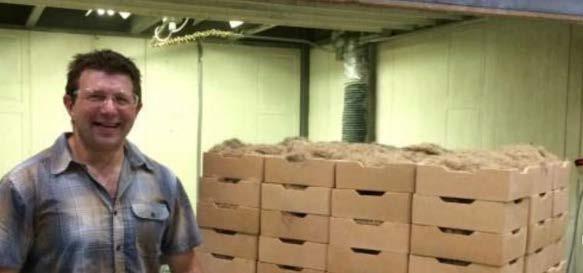
Hemp Conducts Electricity
Hemp has long been known to be a conductor of electricity, especially when wet. Benjamin Franklin used a hemp twine for his 1752 kite-and-lightning experiment and noted that the loose filaments suddenly stood erect and moved toward his knuckle, proving the existence of electricity.
Mitlin and his team found that hemp nanosheet electrodes, used with an electrolyte, created supercapacitors with an energy density of 12 watt-hours per kilogram which could recharge in 6 seconds. That energy density was “on par with or better than commercial graphene-based devices,” the team’s peer-reviewed
74 LetsTalkHemp.com
2013 paper said.
Battery researchers want to perfect supercapacitors, also called ultracapacitors, because they store static energy in large quantities and recharge quickly, as opposed to batteries which work slowly via a chemical reaction and lose their power over time.
Right now, supercapacitors are used to provide a burst of energy in a mechanical setting; for example, regenerative brakes for electric vehicles or to store energy to direct the blades in wind turbines. However, researchers at companies like Tesla are trying to meld long-lasting batteries with supercapacitors to create batteries that charge much quicker. The goal would be a cell phone that charges in seconds or an electric car that charges in minutes.
In 2014, Mitlin’s team formed a startup, Alta Supercaps, to try to produce hemp-based supercapacitors and button cell batteries on a small scale. Unfortunately, in 2015, the company announced on its website that it was closed.
Mitlin, who continues to research battery technology, declined to talk about commercial applications of his hemp battery research.
Bio-waste Can Make a Form of Graphene
Twenty-three Alta Supercaps patents for hemp batter-
ies were acquired by publicly traded Rochester N.Y.based Sparkle Holdings, LLC, which opened in 2018.
“We are creating defect-free, two-dimensional hemp graphene for batteries,” said Sparkle CEO Mick Stadler. The company is developing prototype batteries, supercapacitors, pouch cells and button cells. “We are taking the base science to the next step in battery development.”
Sparkle also grows hemp in Rochester and processes it for CBD.
“Making graphene can be a toxic process. Instead of mining graphite, we process a plant, we make the similar material [a bio-based] graphene from a green process,” Stadler said. “We believe there is a future for a hemp storage technology combination that will be used in electric cars or for storing wind or solar energy.”

Battery scientists, especially in China, are continuing to publish research on supercapacitors using hemp as an alternative for graphene. Researchers are also studying the conductive properties of other bio-waste carbon sources, such as banana peels, pineapple leaves, peat moss, waste paper pulp and the shells of eggs, peanuts and pistachios.
But as of yet, there are no hemp batteries on the market.
Batterty?









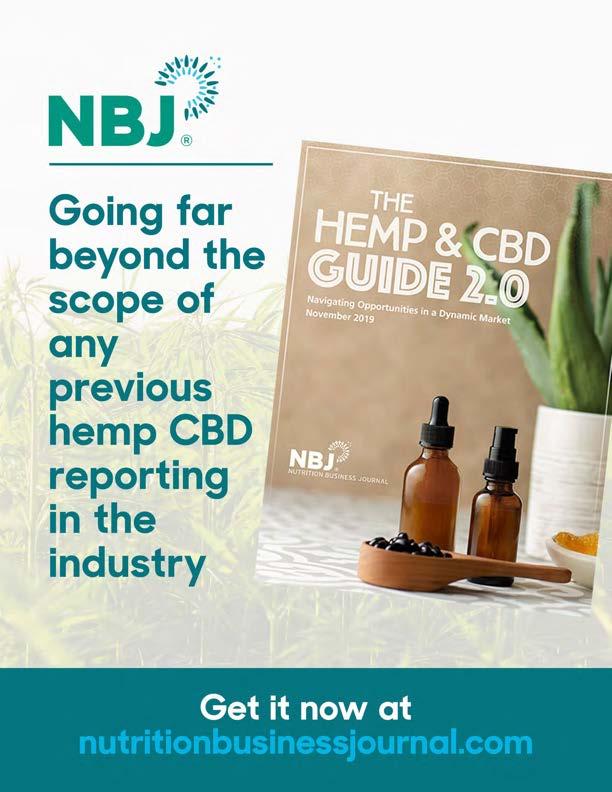
-


















- - - - - - - -

Email us for more information at info@hempevents.org Free listings available Advertising opportunities available VISIT OUR EXTENSIVE LISTING OF HEMP RELATED EVENTS FROM AROUND THE WORLD Order & Preorder Silver Mountain Hemp products @ OnePlanetHemp.com The Sound of HEMP there simply is nothing like it SilverMountainHemp.com
The only national trade show focused on the retail side of the cannabis industry!
Why Exhibit?

4000+ retail attendees. Including health food stores, cannabis retailers, vape shops, etc.
Focused on the retail side of the rapidly growing legal cannabis trade
Dispensaries & retail buyers from across the USA & Canada
Buyers from regional and national chains

LetsTalkHemp.com 79
OCTOBER 6-7, 2020 | LAS VEGAS CONVENTION CENTER
Retail & Dispensary Expo
WWW.THERADEXPO.COM | 425-656-3621 | RAD@MARIJUANAVENTURE.COM Register Today! Produced by: VENTURE M A R I J U A N A marijuanaventure.com


Contact us (844) 708-7087 Follow HLG @hobanlawgroup Or visit Hoban.law for up-to-date cannabis news
HLG has been
to quality, market wisdom, making connections, access to capital and strategic advisory.
HLG is the leading international full-service law firm recognized throughout the cannabusiness™ community for its commercial awareness and commitment to its clients. For over a decade,
dedicated
WHERE DO YOU FIT INTO THE HEMP SUPPLY CHAIN? THE CENTER OF THE WORLD’S LARGEST CANNABUSINESS™ NETWORK
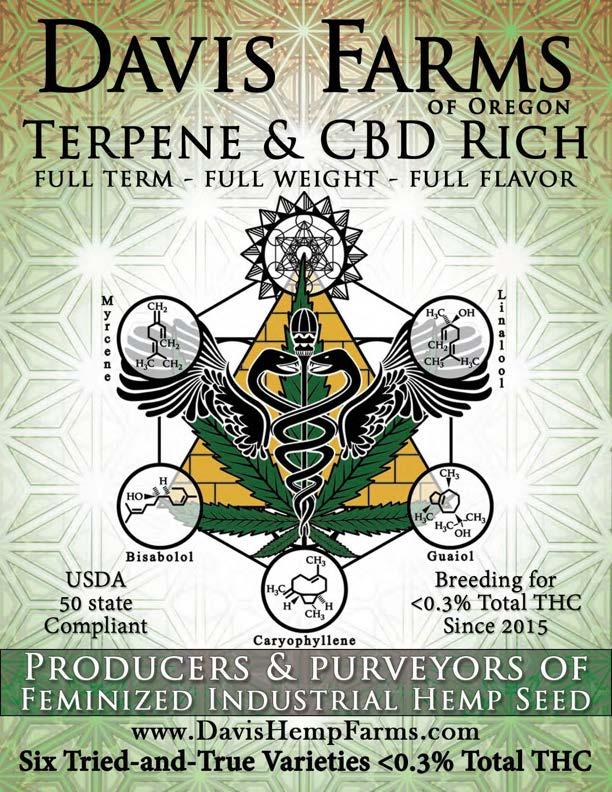



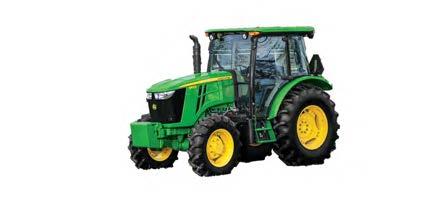









HEMP PACKAGES At 4Rivers Equipment, you can find what’s best suited for your land. Each Hemp Package offered below is tailor-made for any operation size. $68,338 NEW JOHN DEERE 5100E UTILITY TRACTOR $223,211 $376,785 NEW JOHN DEERE 6195R UTILITY TRACTOR



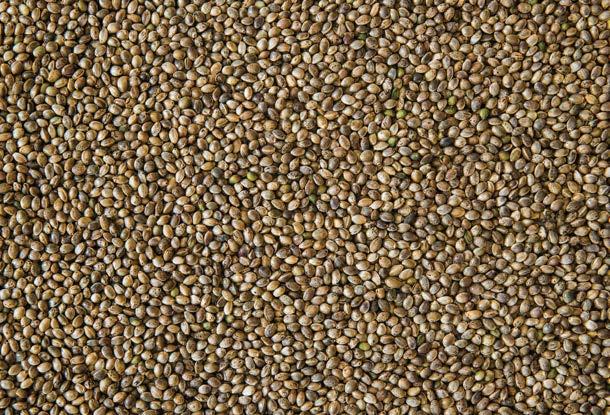

84 LetsTalkHemp.com

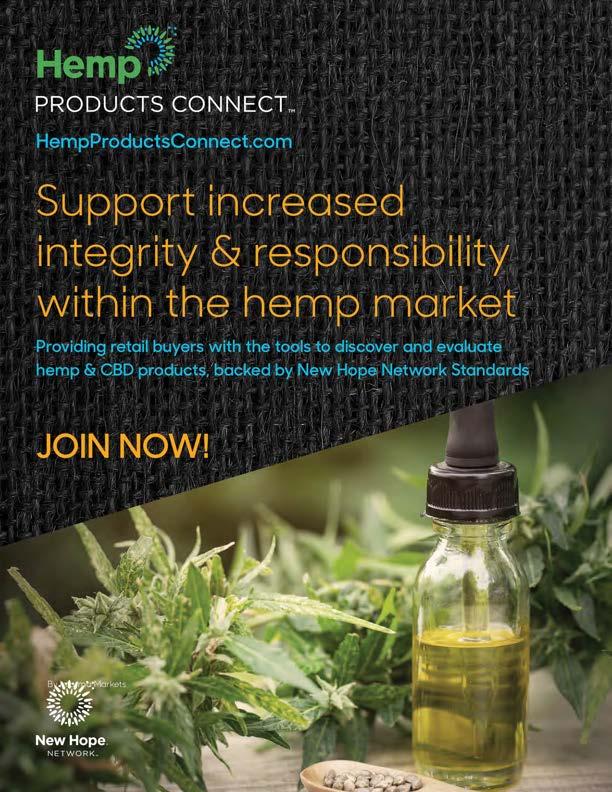

As



a budding market, we want our students to be at the forefront of groundbreaking research, policies, and educational opportunities. Join us as we grow! The Cannabis, Law, and Policy Institute features: Expungements Events Small Business Incubator Educational Events And other Social Initiatives


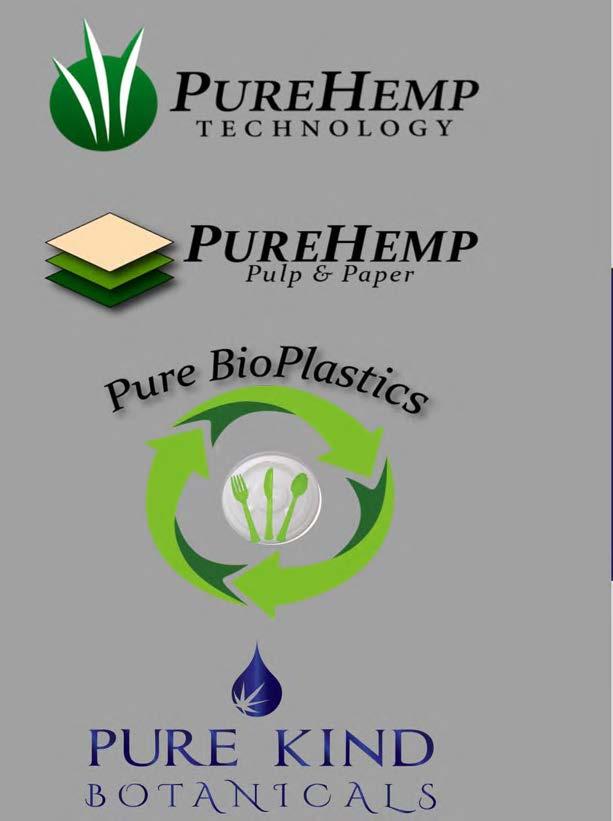



The Clear Path Extraction & Distillation Learn more by visiting www.helderpad.com, or call us at: (312) 884-1716




To Perfection™ Distillation Equipment 884-1716 Have a Question? Get a Straight Answer. info@phytologix.solutions | +17208390559 Helping Cannabis/Hemp Operators Succeed for Over a Decade
What new
mean for cbd

new THC Regs
 By Dan M., CBD Seed Labs
By Dan M., CBD Seed Labs
It used to be so easy… Almost anyone could throw a few seeds in the ground and get some nice hemp plants with double digit CBD percentages: 10, 15, even 20% CBD was the norm. Then came the USDA Interim Final Rule (IFR) and double digit CBD percentages are going to be a thing of the past unless we speak up. The IFR governs the production of hemp as outlined in the 2018 Farm Bill, establishing federal protocol for producers in states that do not have their own hemp plan. Within the IFR are regulations for such points as regular tests on the levels of Delta-9 THC, disposing of plants which do not meet the necessary requirements, and ensuring compliance with all requirements as laid out by the ruling. Currently the IFR is in effect until November 2021, at which time it will likely be reviewed again by federal authorities.
Total THC vs Delta-9
One of the key aspects of the IFR is the switch to Total THC from Delta-9. Before the IFR, hemp was defined as any Cannabis Sativa plant which had a Delta-9 THC level less than 0.3%. Life was simple then, as there are an abundance of high-quality hemp cultivars which can fully mature and achieve a Delta-9 THC level of less than 0.3%. But the switch to Total THC is a complete game changer. First and foremost, there are virtually no hemp cultivars that a farmer can grow to full
maturity and consistently achieve total THC levels below 0.3%. Anyone who tells you otherwise is just plain wrong. Second and just as important, this also means that there are almost no cultivars out there capable of reaching double digit CBD levels
CBD to THC Ratio
Cannabis comes is 4 basic varieties when is comes to cannabinoid content:
Type I THC > CBD - Marijuana, Weed, Dank, Bud, etc.
Type II THC = CBD - Still marijuana, just not as strong. Some classic strains and modern medical strains match this profile.
Type III CBD> THC - High CBD Hemp flower; what you need to make CBD products.
Type IV CBG dominant - These plants are severely deficient in the necessary enzymes to convert CBG ( the chemical precursor of all cannabinoids) into THC, CBD or any of the other cannabinoids.
Since the resurgence of hemp farming in America, most hemp farmers have been focused primarily on Type III Cannabis, this kind with more CBD than THC. As it turns out, these plants produce their cannabinoids in relatively consistent ratios. The average hemp strain has a CBD: THC ratio of approximately 20:1 which means there is 20 parts total CBD for every one part total THC.
cbd
(https://onlinelibrary.wiley.com/doi/10.1111/ gcbb.12667 )
Let's Do Some Math
So using the IFR, which requires a total THC of less than 0.3% and a 20:1 CBD to THC ratio, we can estimate the final CBD percentage of a hemp plant grown to the legal limit.
20 CBD : 1 THC ---> 6% CBD : 0.3% THC
Yup, 6% percent is the maximum amount of CBD a farmer will be able to get out of the average commercially available high CBD hemp strain right now. I hope that’s the number most of you are using when you are calculating your profit per acre, because if you are counting on more than that, you are most likely going to end up disappointed.
What Can I Do?
First and foremost, You could find better genetics with better ratios. Elite genetics have at least a 25:1 ratio with a few rare and unique cultivars approaching 28:1 or even 30:1. In fact, the same research study mentioned above tested 207 different plants and the highest ratio they found was 32:1.
Let's do a little bit more math
Again we will use the new interim final rule which requires a Total THC of less than 0.3% and a 20:1 CBD to THC ratio we can estimate the final CBD percentage of a hemp plant grown to the legal limit.
20 CBD : 1 THC ---> 6% CBD : 0.3% THC
25 CBD : 1 THC ---> 7.5% CBD : 0.3% THC
28 CBD : 1 THC ---> 8.4% CBD : 0.3% THC
30 CBD : 1 THC ---> 9% CBD : 0.3% THC
32 CBD : 1 THC ---> 9.9% CBD : 0.3% THC
So the highest tested ratio out of 207 plants was 32:1 which equates to 9.9% CBD when harvested legally under the IFR. That means that anything over 10% CBD is virtually impossible when harvested legally!!!
If you’ve been promised better numbers, beware!
But I’ve Seen COAs from Breeder XYZ That Claim 14% CBD and Less Than 0.1 THC!?!?
Yeah so have I, and then I‘ve talked to the people that grow those genetics and they tell me a whole different story. I’ve even splurged on a few of those seeds, and guess what? 20:1, maybe 25:1. Nothing extraordinary. A colleague of mine has a wonderful name for those COAs; she calls them “Vanity COAs,” which is pretty fitting, but we just call them bullshit COAs.
I think there are a wide variety of practices when it
comes to making a COA for marketing purposes but I wouldn’t trust anything that claims more than 10% CBD this year. I’ve talked to a few breeders who have 35:1 or 40:1 plants in the works, but they are not stable. Who knows if they will ever be? And they haven’t been released for public consumption.
Wait, What Else Can I Do?
Well, you could quit, because hemp farming isn’t going to make you an instant millionaire.
OR
You could grow plants that yield more per plant or increase your planting density to increase your overall yield.
OR
You could focus on other aspects of the plant, like terpenes, fiber, pulp, etc.
OR
Hire a consultant who has experience growing hemp and knows how to coax the best possible cannabinoid ratio out of your crop.
OR
You could find high-yielding genetics, with other potential end uses that also have at least 25:1 CBD to THC ratios, hire a consultant and still end up a millionaire (after a few seasons).
Test Early, Test Often
Of all the advice I give to my clients, the most common is “Test early, test often,” yet it’s the most commonly ignored. I am amazed how many farmers are willing to drop 50k, 100k, 500k or more on setting up their grow, but balk at the idea of proper testing.
Make no mistake, if your crop goes hot, you could lose it all. The time interval between beautiful legal hemp and hot, high THC, illegal weed is inconsistent at best. There are so many variables affecting your plants, and no one can tell you exactly when they will cross the threshold, which is why you must test early, and often. During the last few weeks before harvest my clients are testing 2-3 times/week at a minimum in order to maximize their profitability and you should too.
The difference between a plant with 0.2 THC and 0.3 THC is about 2-3 CBD percentage points, which could be worth thousands of dollars to your bottom line.
Focus on a Quality Product
CBD percentages are only one part of a quality hemp plant. Depending on your end product goals, the look, feel, smell, density, terpene content, yield, pest resistance, height, harvestability, etc might be significantly more important to your bottom line. There is a saying we like to use in the industry: “If it smells good, sells
96 LetsTalkHemp.com
good,” and since selling the end product is most everyone’s goal, focusing on fragrant-high terpene plants can be the difference between boom and bust. Because hemp is a living organism, it is critical to select genetics which produce hardy, healthy, resilient plants that are able to tolerate the various stresses nature can dish out in order to maximize your chances of success. We don't buy cars solely on what goes the fastest or what gets the best MPG, do we? We buy cars based on what fits best into our lifestyle, meets our needs and matches our budget. Buying hemp seed is no different.

What about CBG? Aka Type IV
We have mixed feelings about CBG strains right now. CBG is a precursor molecule that's usually only present in tiny quantities. We as a human species do not have a longstanding relationship with the molecule the way we do with CBD, THC, CBN, etc. There is also very little research about the long term potential effects of CBG, positive or negative.
One thing we do know is that the new type IV cannabis can be grown to full maturity and achieve a total THC less than 0.3% which is awesome, but what’s the CBG really worth? Only time will tell, so while experimenting with a small CBG grow could be worthwhile,
I wouldn’t recommend putting all my eggs in that one basket quite yet, as high-quality CBD products still have a significant consumer demand.
A Final Word
The IFR is, for all intensive purposes, garbage. It’s time to speak up. Phone or write your Congressman or Senator and let them know what you think. 0.3% total THC is a completely arbitrary number to classify what makes a legal hemp plant. Everyone would be better off with a more realistic number, like 1.0% total THC, which is still far less potent than even your grandpa's marijauna. Even 0.6% total THC would allow a decent amount of cultivars to get to full maturity and still produce a significant amount of CBD. Or we could go back to using delta-9 (some states like Vermont, Oregon and a few others are sticking with delta-9 this year). These less stringent rules would allow farmers to have a great chance at successful hemp farming and potentially produce a more mature, more beneficial end product. Questions, Comments or Concerns?
Shoot me an email at cbdseedlabs@gmail.com or gimme a call at 442-222-8595 I would love to talk with you and learn about your project.
Sincerely,
Dan the Man
1996 CANNABIS CUP REPORT
By John Dvorak, Hempologist (boston. hemp@pobox.com)

EDITORS’ NOTE: In the modern era, few events have been as integral to the cannabis and hemp communities as the High Times Cannabis Cup. The 9th year of festivities, held in Amsterdam in 1996, proved particularly significant for the recognition of the then-nascent American hemp industry that was beginning to emerge. In pivotal sectors, American companies took home the wins for products and business concepts that had nothing to do with how bud potency and everything to do with the plant’s versatility. As we celebrate the centuries of hemp history that have led us to the current exciting future, we take a look back at the milestones that unfolded 24 years ago in the words of an eyewitness. Here, hempologist John Dvorak shares his first-person account of the industry and key issues as they were then. We leave it to readers to decide how far we have come and how much further still we can go.
The Expo at the 9th Annual High Times Cannabis Cup was held at the Pax Party House in Amsterdam from Saturday, November 23 through Monday, November 25, 1996. In addition to over 30 companies and organizations associated with industrial hemp, the Expo contained exhibits by several purveyors of products concerning the cultivation and consumption of THC-laden cannabis.
As the vendors began arriving at the Pax on Saturday morning, it was like watching a family reunion. Hugs, handshakes, and smiles abounded as people filtered in and started setting up their tables. The hemp industry is composed of people who are dedicated to spreading the truth about the beneficial properties of an outlawed plant. If, through their hard work they make a profit, then another dagger is slipped into the heart of prohibition. Established industry leaders including The Ohio Hempery, Two Star Dog, Headcase, and Ecolution were well represented at the Expo, as were some newer concerns such as the Austin Hemp Company, Lost Harvest, and Planet Hemp.
Most of the participants in the weeklong Cannabis
Cup festivities were American readers of High Times magazine. The Expo exhibitors, on the other hand, provided a more international flavor with representatives from several countries including the Netherlands, Germany, Switzerland, Poland, Hungary, Australia, and Canada. The fact that the resurgence of the hemp industry is a global phenomenon lends credence to the overall movement.
AND THE WINNERS ARE:
The Ohio Hempery, one of the oldest and most successful hemp companies in the world, again won two Cannabis Cups. This year, they won for Best Hemp Product and Best Hemp Fashion. The Hempery’s founder, Don Wirtshafter, is tireless in his quest to educate the public about hemp. His sage advice and kind smile keep him in constant demand.
Two Star Dog’s quality clothing products brought them a Second Place Medal in the Hemp Fashion Category. Their shirts, jackets, and jeans are consistently some of the best hemp products currently available. Two Star Dog’s line of Body Dope hemp and essential oil body care products carry on this tradition.
Ben and Alan Dronkers, won a 3rd Place Medal in the Hemp Product category. The Dronkers, who are often mistaken for brothers, also operate the Hash Marihuana Hemp Museum and the Sensi Seed Bank. They are now investing big time in industrial hemp. In this, their 3rd year of hemp farming, HempFlax worked with over 100 farmers to grow several thousand acres of hemp. Much of hemp fiber from these crops is currently being stored in a warehouse for future processing. Individuals interested in investing in the “stalk market” should contact them. Because of the U.S. prohibition on the production of cannabis/hemp, the equipment to harvest and process it has not advanced much in the last 80 years. HempFlax has taken the initiative and made the investment to develop machinery that can more efficiently harvest the hemp and process it by separating the woody inner hurds from the stringy outer bast fiber. The result of their work was apparent on the Expo floor as large numbers of people came by to discuss their products, watch their hemp farming video or gawk at the hemp plants that brushed up against the 12-foot ceiling.
JD’S HONORABLE MENTIONS
The most pleasant surprise in the judging occurred when the Austin Hemp Company won the Third Place Medal in the Hemp Fashion category. Although the Austin Hemp Company has only been in existence for a short time, their decision to develop new, innovative, and stylish clothing paid off. Their hemp/silk “Marilyn Monroe” dress is sure to be a big hit.
HempFlax, a Netherlands-based company headed up by the father and son team of
The International Hemp Association is a nonprofit organization based in Amsterdam. This dedicated group of individuals, led by David Watson, David Pate, and Robert Clark, is performing yeoman work collecting and disseminating information about hemp. The Journal of the IHA contains a veritable cornucopia of information relating to all aspects of hemp. The IHA is also trying to preserve Europe’s cannabis germplasm to revive the viability of different strains of cannabis and to confirm their identity for future use by plant breeders. This project requires additional funds to achieve its goal.

HanfHaus, which operates 20 retail stores in Germany, had a very small amount of table space at the Expo to exhibit their wares. They did, however, have room to display a THC-free hemp beer that gives new meaning to the slogan “this bud’s for you.” HanfHaus’s impressive 36-page catalog contains dozens of “hanf” products including fabric, clothes, paper, cosmetics, laundry detergent, paint, mattresses, and yes, even a hemp couch!! As you can tell, the guys at HanfHaus are very serious about their hemp. The near future may even see HanfHaus stores opening in America.
The brother combination of Eric and Wes Crain had their rugged and comfortable Eco Dragon sandals on display at the Expo. These hand-crafted sandals contour to the shape of your foot, massaging and energizing your feet as you go. Their strategy of producing high-quality, affordable products seems to be working.
Denny Finneran of Crucial Creations had his usual collection of high quality 100% true hemp men’s and women’s clothing on exhibition. A jaunty plaid suit also made its debut at the Expo.

Australian Hemp Products had their new hemp
The guys at Earth Goods from Seattle had a very nice selection of reasonably priced hemp clothing for men and women on display. Earth Goods uses 100% hemp for some of their clothing items and hemp/silk or hemp/cotton blends for others. The colors resulting from their natural dying process are “earthy”, which I love. For instance, there are several shades of brown to choose from when picking out one of their shirts, skirts, dresses, blouses, or jackets.
Lost Harvest proudly showed a wide range of products that they manufacture out of colorful hemp cloth. These items, which include wallets, hats, hacky sacks, flying disks, fanny packs and hand-bags all stand up to Ethan Jule’s exacting standards. Lost Harvest’s motto is: “You know you’re going to have fun, so have fun with hemp.” How can you go wrong with that?
T-shirts on hand for all to see. Operations Manager
Brett Lock explained to me that design and stitching improvements were made to this, the second generation of their highly sought-after hemp T-shirt. A large selection of bright colors complements the natural color of the original design. Australian Hemp Products’s beautifully photographed catalog shows that the Aussies know about more things than just beer.
Valchanvre Incorporated, a Switzerland-based company, has developed several 100% natural products that utilize the nutritious and aromatic qualities of hemp seed oil. They have made a commitment not to use chemical solvents in the preparation of their hemp seed oil, massage oils or perfumes. Valchanvre’s “Indica” and “Sativa” perfumes exude a most kind fragrance. Their massage oils contain at least 98% hemp seed oil, with the remainder being made up of natural essential oils blended


by an aromatherapist. To top it all off, their hemp seed oil is produced using the healthy cold pressing method.

REEFER GLADNESS
The City of Amsterdam deserves special recognition for providing the atmosphere of tolerance that allows the Cannabis Cup to exist in the first place. The 400 or so cannabis coffeeshops in town do not prevent Amsterdam from being one of the safest, cleanest, and most efficiently operated cosmopolitan cities in the world. In actuality, the coffeeshops contribute to Amsterdam’s remarkable prosperity by increasing tourism and decreasing drug-related crime.
Instead of incarcerating their cannabis users, the Dutch regulate and tax them, thereby turning a ban into a boon. The Dutch philosophy of tolerance basically means that you can do anything you want as long as you do not harm another person. The legitimization of cannabis reduces the influence of organized crime and hard drug pushers. As more Americans visit Amsterdam and realize that cannabis regulation actually works, the word will spread that tolerance can, in fact, be tolerated. Perhaps a fund should be started to send American politicians to Amsterdam so that they can see firsthand how well the Dutch system works. Anyone
up for a road trip with Jesse Helms and Orrin Hatch?
Despite this illusion of paradise, a pall of misery still covers the hearts of many. America’s War On some Drugs has caused thousands of nonviolent citizens to flee the land of the free. These “reefer refugees” come to the Netherlands to seek asylum from draconian laws. However, as Les and Cheryl Mooring are finding out, the long arm of American “justice” is far-reaching. The Moorings have been held in a Dutch jail for over a year, awaiting extradition back to Clinton County, Arkansas for allegedly violating America’s cannabis laws. The Green Prisoners Release Amsterdam organization is working to free the Moorings and others. Paul J. Van Hartman is one of the dedicated volunteers who has tirelessly worked to spread awareness of the Moorings’ plight. Paul’s impassioned speeches throughout the Cannabis Cup informed the visiting Americans of the
LetsTalkHemp.com 101
need to help abort this miscarriage of justice. The emotional impact of this issue was evidenced through the awarding of a Cannabis Cup for Best Expo Booth and a Second Place Medal for the overall Cannabis Cup to the Green Prisoners Release Amsterdam organization. Please do all you can to support their cause. [NOTE: Since this was originally written, the Moorings have been extradited back to America, “land of the free”.]
smoke-ins, and business meetings were commonplace. The foundation of the nascent hemp industry was being laid. It is up to all of us to build upon this foundation.
ROPE, DOPE, AND HOPE
Throughout this year’s Cannabis Cup, I felt as if I was standing at ground zero of a new era. All the lies of the past were being obliterated by the truth that hemp can, and will lead us into a more prosperous future. Some of the most active and intelligent people in the world of hemp were there. In addition to the people mentioned above, attendees included: Jack Herer, Dennis Peron (Yes on 215!!), Marc Emery, French Hemptress Michka, Dick Cowen, Steve Hager, Larry Dupree, Mari Kane, Todd McCormick, John Howell, Dr. Alexander Sumach, Arjan, Hash Queen Mila Jansen, Stephen Gaskin, Jerzy Przytyk, J. P. Morgan and Eagle Bill. All of the major disciplines of hemp were represented: industrial, medicinal, recreational, religious, environmental and activism/legalization. Impromptu bull sessions,
The Cannabis Cup is a place for people to get together and rejoice in the fact that they have not succumbed to the brainwashing of the media, politicians, and big business. I was lucky enough to be able to attend this year’s Cannabis Cup. Even if you can’t make it to Amsterdam to enjoy true freedom, you can have your own Cannabis Cup. It’s easy. All you have to do is buy, make or sell hemp products, work to legalize hemp, research the historic uses of hemp, or just talk to people about hemp. Then, go out and vote for hemp friendly political candidates. You’ll be surprised at hemp’s vast and varied past, and awed by its seemingly infinite future.
America’s insane prohibition of cannabis/hemp prevents:
• farmers from growing the most versatile plant on the planet,
• millions of people from processing cannabis/ hemp into thousands of products,
• us from healing the environment that has so thoughtlessly been ravaged,
• millions of people from using one of the safest therapeutic substances known to man to relieve and/or cure numerous diseases and ailments,
• all Americans from being truly free.
The most significant tragedy resulting from cannabis/hemp prohibition involves the arrest of over 500,000 Americans a year for cannabis possession, cultivation, or distribution. That’s one half of a million individuals who are generally upstanding, tax paying, members of society. The amount
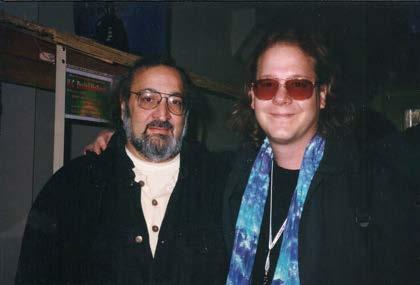
 All photos courtesy of John Dvorak
All photos courtesy of John Dvorak
of resources wasted to track down, arrest, adjudicate, and incarcerate these people is truly staggering. Persecuting people for this nonviolent offense will surely be looked back upon as one of humanity’s greatest follies. Write your politicians and newspapers explaining to them that you do not agree with this heartless policy.
(A version of this article was previously published in Hemp Magazine)

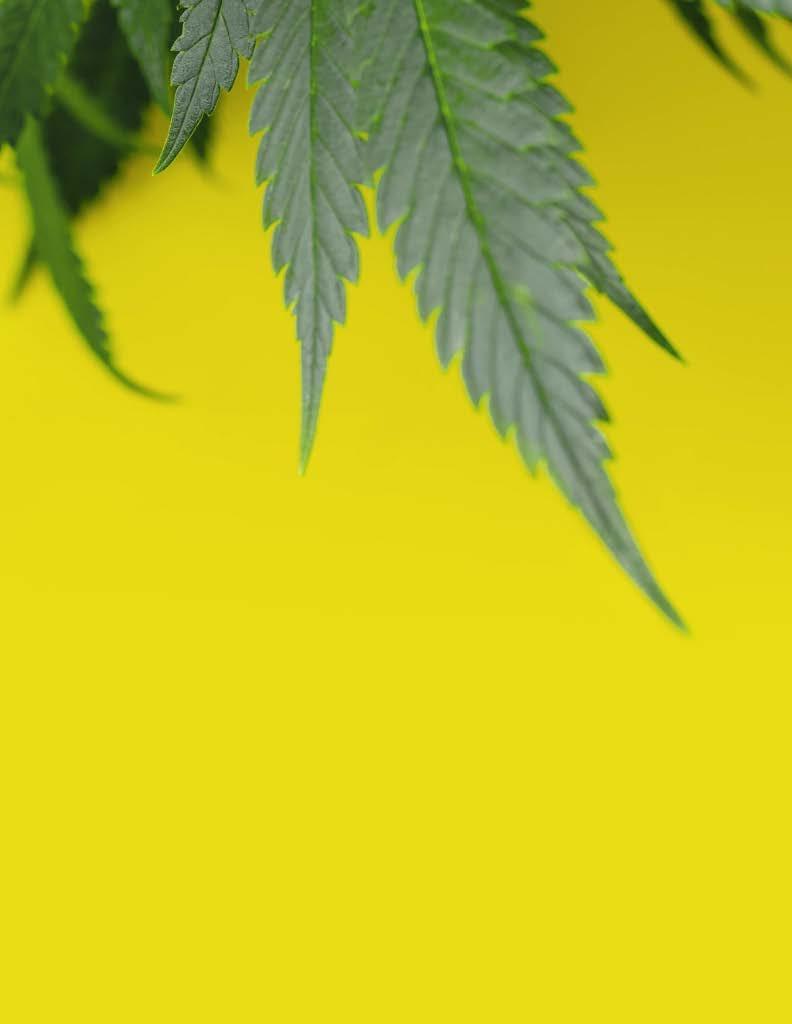
Cannabis Extracts
By Emma Chasen on behalf of Feel State
In the legal cannabis industry, there are many products to choose from. Cannabis extracts and concentrates have seen a particular rise in popularity in developing markets. Cannabis extracts are products that have highly concentrated can-

nabinoids and in some cases, terpenes. Consumers often enjoy extracts via vaporization or dabbing.
Not all cannabis extracts are created equal. Recently, people have been developing lung injuries from the consumption of vaporization devices including cannabis extracts and e-cigarettes.
The CDC (Centers for Disease Control and Prevention) released a report this fall on the outbreak of lung injuries associated with vaping and vape products. As of November 20, 2019, 2,290 cases of vaping-associated lung injury have been reported from all over the country and 47 deaths have been confirmed. Vaping is often marketed as a healthier alternative to smoking, but the recent outbreaks urge us to re-evaluate the safety of these products.
It is imperative that when selecting cannabis extracts and concentrates you conduct an investigation of the company’s ethos and formulation practices. Ultimately, you want to make sure you are only consuming 100% pure cannabis extract that comes from high-quality plant material. Unfortunately, companies may include additional ingredients to favor profits, amplify flavor and/or decrease the likelihood for device failures.
alveoli from properly exchanging gases, thereby preventing the absorption of oxygen. This can result in a life-threatening disease called Lipoid Pneumonia. In its most recent report, the CDC released this statement: “CDC has identified vitamin E acetate as a chemical of concern among people with e-cigarette, or vaping, product use associated lung injury (EVALI).”
Thinning Agents - Propylene Glycol
Vaporization devices can experience issues if the extract is too thick. Therefore, companies will use thinning agents to reduce the likelihood of cartridge failures. Propylene glycol is one such thinning agent. While propylene glycol is safe to eat and apply topically, it is NOT safe to heat and inhale. When heated, it turns into formaldehyde, an incredibly toxic compound. An easy way to test if a cartridge has propylene glycol is to flip it over. If the extract immediately runs to the other side, it most likely includes a thinning agent and should be avoided.
Non-Cannabis Terpenes
Here are some common adulterants to watch out for when evaluating cannabis extracts:
Thickening Agents - Vitamin E Acetate, Olive Oil

Cartridge companies may include vitamin E oil or olive oil to “thicken” the cannabis extract. This allows companies to cut costs and increase profits as they can use less cannabis extract in each cartridge. While vitamin E oil and olive oil are completely safe to eat and apply topically, they are NOT safe to heat and inhale. Our lungs are built to exchange gases, not to waste out foreign compounds. When oil is heated and inhaled into the lungs, it coagulates and blocks the
This is big as many companies add terpenes to distillate - a type of cannabis extract that includes a highly potent, albeit small range of cannabinoids without terpenes. The added terpenes are used to enhance the flavor of the cannabis extract when vaped. These terpenes are often botanically derived or synthesized in a lab. Either way, they should be avoided. When exposed to high heat, terpenes may transform into carcinogenic compounds, such as benzene. If you want a cannabis extract that has a higher concentration of terpenes, choose a live resin extract that has undergone subcritical CO2 processing. This extraction methodology will preserve the terpenes present in the original plant material and deliver a naturally delicious flavor to the extract without compromising safety.
Vaporization Device Hardware
Lung issues may also arise from the hardware of the device. What is the vaporization device made of? Where does it come from? These are questions that must be considered when evaluating vapes as heavy metals, plastics, cotton, and synthetic materials can leak into the extract when heated.
Pesticides
Even if the vaporization device contains 100% pure cannabis extract, you must evaluate the quality of the plant material used in extraction. Pesticides present in the original plant material, even in miniscule concentrations, can become concentrated to substantial amounts in the extract. One such pesticide that has been present in cannabis extracts is myclobutanil. When myclobutanil is heated and inhaled, it transforms into cyanide. Cyanide is highly poisonous and should be avoided at all costs.
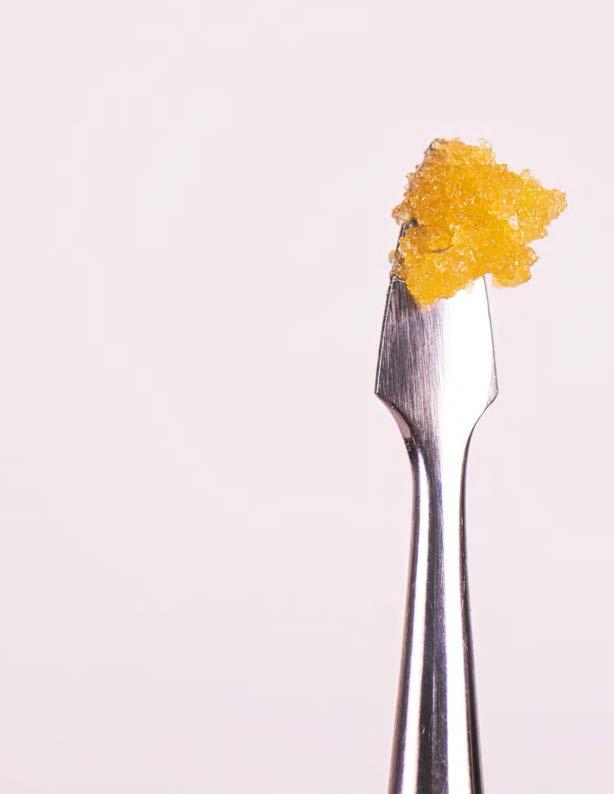
Vaping cannabis extract can be a very enjoyable, easy and discreet way to consume. However, when choosing a vape product, a rigorous investigation into the company’s ethos and formulation practices is imperative. Choose companies that formulate with clean, high quality plant material and only include 100% pure cannabis extract in their products.

EMINENT
CANNABIS EDUCATION PROGRAM
We have a mission to educate and empower learners to act as virtuous, successful stewards of cannabis.
WHAT WE OFFER:



·Comprehensive online training on the fundamentals of cannabis science to help you and your sta deepen your understanding of cannabis and its purported e ects



·Strategic planning and business development for emerging cannabis entrepreneurs






CBD CHOCOLATE & WELLNESS FORMULAS

Founded on the commitment to create premium, functional products using organic and impeccably sourced real food ingredients that ultimately support your wellbeing.
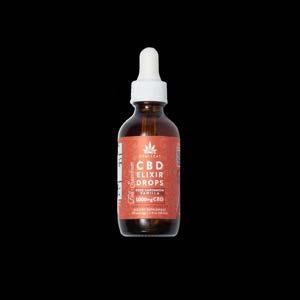


LetsTalkHemp.com 107
GET IN TOUCH WITH US FOR MORE INFORMATION: info@eminentconsultingfirm.com
@ CLICK TO LEARN MORE PLANT
CBD VITALLEAF.COM
www.eminentconsultingfirm.com eminentconsulting
FORWARD




LetsTalkHemp.com 109





110 LetsTalkHemp.com In a fast moving industry As the hemp sectors continue unprecedented expansion. Trust is essential to saving time, building brand value and establishing profitable relationships. Suppliers you can depend on We research and qualify all vendors, and have long-standing business relationships with many of the producers who offer their goods through HempTradePro.com. Quality & service guaranteed Our vendor-partners’ products are of the highest quality. You can depend on a secure, dependable supply channel and highly responsive, personal service. www.hemptradepro.com HEMPTRADE Trust. WHOLESALE BRANDED, BULK WHITE LABEL LISTINGS BEGIN AT €100/YR. To connect your company with the HempTrade network of qualified buyers and sellers, contact us on +48 602 336 685 or email info@hemptradepro.com
HEMP INNOVATION CHALLENGE 2.0

THE FINAL FRONTIER LAUNCHING 2021


HEMPINNOVATIONCHALLENGE.ORG/ NOW ACCEPTING PROJECTS









LetsTalkHemp.com WEEKLY NEWSLETTER | DIGITAL MAGAZINE & PODCAST Keep up-to-date with the best curated cannabis & hemp industry content on the web Ball Coleman Seed Counter • Fastest and most accurate counter on the market • Hemp seed counting speed 250-300 per second • Easy to use with minimal maintenance • Designed and made in USA Contact us at 630.588.3261 Email: gtrabka@ballhort.com Gen3 S www.ballcoleman.com
DOWNLOAD OUR APP!





114 LetsTalkHemp.com HSHONEYPOT.COM


SUMMER 2020 VIRTUAL EVENTS Products for the planet! EXPERIENCE HEMP LIMITED OnePlanetHemp.com COLORADO HEMP PRODUCTS - LOCAL - SUSTAINABLE Apparel, Posters, Bags, Books, & More PRODUCTS FOR THE PLANET OnePlanetHemp.com
JOINT
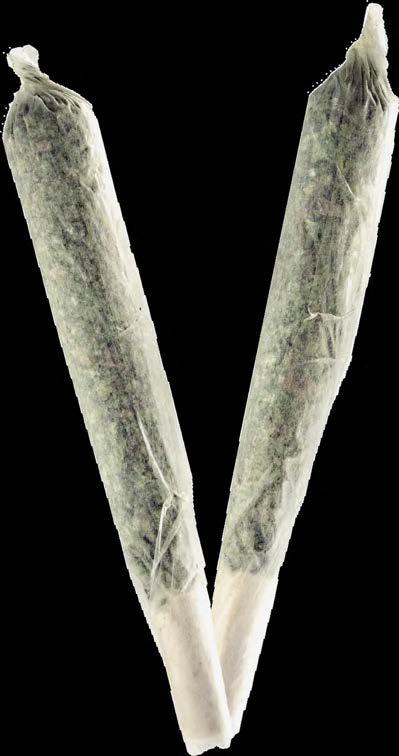
ENTURE
116 LetsTalkHemp.com
JOINT
By: Luke K. Stanton and Jeffrey D. Welsh Vicente Sederberg LLP
When is a strategic partnership or joint venture right for your business?
One of the biggest mistakes a cannabis and hemp business owner can make is trying to do everything alone. To ensure this mistake is avoided, business owners should first develop the right internal team and then look to strategically partner or create a joint venture with another business that compliments their team’s core competencies, helps them achieve stated goals, develops new products, provides access to new markets, resources and distribution channels, increases valuation, shares in risks or costs, or otherwise provides the business with a competitive advantage.
Financial Partners
Cash flow is the lifeblood of any business, and financial partners include accountants, bankers, investors, or financial advisors that can help monitor, increase, or come up with new solutions relating to the cash flow of your business. While financial partners are the most obvious and common partnership, the success of this alliance can determine the success of your business, and its importance bears repeating.
Marketing Partners
This partner must share the vision for the business that the owner has moving forward in an effort to capture the synergistic effect that a successful partnership or joint venture cultivates. The right strategic partner can scale your business, build your brand reputation, give you access to a broader audience, and increase your market share. Common types of strategic partners include:
Effective marketing can be the key to taking your cannabis business to the next level. It is still extremely common to meet a young cannabis business owner who does zero or very little marketing of its products or services, and this is usually a result of a lack of capital. One solution to this issue is to develop strategic marketing partners who are in a complimentary business that can help grow a business at a very low cost through a simple referral arrangement, resulting in increased revenues without additional advertising costs.
Supply Partners
Manufacturers, distributors, and vendors supply a cannabis business with everything it needs. Developing a partnership or working closely with a supplier will ensure your business runs smoothly as it relates to
LetsTalkHemp.com 117 ENTURE
timely deliveries and shipments, and it may even lead to discounted services or products. Most importantly, supply partnerships potentially provide the business owner with an opportunity to develop new products tailored to the business owner’s specific needs, giving the business and its products a competitive advantage in a marketplace that is open but quickly filling up.

Technology Partners
The modern world is heavily reliant on technology, and the cannabis business is no different. With a multitude of businesses operating exclusively online, the services a technology partner can provide may range from implementing office networks, creating or refining existing digital systems or software, or even designing or managing a cannabis business’ web-based presence. A successful technology partner can ensure your business remains competitive at the digital level, which is particularly important if the tech world is not within the core competencies of existing team members.
But how does a cannabis business owner determine who to partner with, and how should potential partners be evaluated?
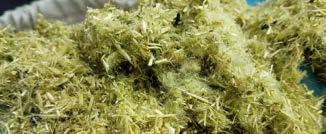
Access to Other Networks?
Does the potential partner have access to networks that you don’t? Who are their other partners, if any, and how do they benefit your business? Does this new network help fill the gap in what you need in order to obtain the complete solution?
Compatibility?
Is the culture and management team of your potential partner compatible with yours, and do you have compatible core competencies?
Impact?
How much value does the potential partner bring to your business? Would the alliance impact your competitive position, brand awareness, or market traction?
Reputation?
What is their attitude to collaboration, and do they share your level of commitment? Do they have a good reputation with their current partners, if they have any? Do their brand values complement yours? Have you researched them as thoroughly as possible?
1. Define and Validate The Market
You must first identify your target market, which will allow you to see who your customer base is and what solutions you can provide that will benefit them the most. Through this process, you can identify the gap between what would be a complete solution and what your business currently delivers. This gap represents your partnering roadmap and represents where you need to partner to deliver a complete solution. In a cannabis world with a constantly evolving regulatory landscape, you’ll likely never have enough capital or resources to ever deliver a truly complete solution, but, through an honest evaluation of your business’ core competencies, filling the gap with appropriate partners can bring you as close as possible.
2. Finding The Best Fit
Sit down with your team and identify the most important criteria for finding the best fit. Areas to consider include:
What is the professional history of their respective management team? Can you trust them?
Risks?
What are the risks in moving forward with this potential partnership? Are they financially secure? Is there an imbalance in levels of expertise, investment or assets brought into the partnership or venture? Is your team comfortable with the partnership, or do they feel threatened?
Similar Goals?
Does the potential partner share similar goals and objectives of your business?
Are all interests aligned to maximize the potential to create a successful, long-term, synergistic alliance?
3. Prioritize, Prepare, and Partner
118 LetsTalkHemp.com
Using the criteria you’ve identified from the steps above, prioritize potential partners based on your evaluation of them. Even if you have a pre-existing relationship with a potential partner, you only have one chance to make a first impression as it relates to your business acumen and professionalism. Approach the potential partnership the same way you’d approach targeting a key client acquisition, and be able to answer why a potential partner would want/need to partner with you, and what you bring to the table that helps them compete more effectively.
ting out objectives, financial contributions, whether any assets or employees will be transferred, ownership of intellectual property created, management and control, how liabilities, profits, and losses are shared, how any disputes between the parties will be resolved, and an exit strategy, how the partnership or joint venture will work and how any income will be shared.

Understand the company’s goals, objectives, and strategies and what’s happening to them in the market, and, if you don’t know, ask! Think through what your combined value proposition would be to customers. Identify a compelling vision for the partnership and articulate the impact of that vision on the marketplace. Lastly, make sure the potential partner knows exactly what you are proposing through the use of a business terms document, such as a letter-of-intent.
Before rolling a celebratory joint, realize that after the new partnership or joint venture has been formalized through a written agreement, the real work begins. Your new alliance must develop a plan that outlines both short and long-objectives and goals, courses of action, individual responsibilities, and checkpoints. The health and happiness of the overall relationship should be carefully monitored, as unhappy partners can quickly snowball from minor issues to separation if not dealt with swiftly and appropriately through transparent and immediate communication.
The way you set up your partnership or joint venture affects how you run it and how any profits are shared and taxed. It also affects your liability if anything goes wrong. You need a clear legal agreement set-
Improved efficiency and better yield for processing industrial hemp. KannaMill is the most efficient, fully scalable equipment on the market for CBD processors. kannamill.com | techsales@kannamill.com800/447-4634





TOTAL CROP
By Steven Hoffman
Working with farmers and production facilities in the Netherlands, Germany and Romania, early mover and European leader HempFlax is stretching the boundaries of industrial hemp innovation with sustainable raw materials and semi-finished products for multiple applications
When HempFlax was founded by trailblazer Ben Dronkers in 1994, the hemp industry was still in its proto-infancy. From having to develop its own custom farm machinery to innovating products that make use of every part of the industrial hemp plant, the Netherlands-based company literally had to invent everything, from the ground up.
Today, HempFlax has grown into a world leader in hemp production. Working with a group of 70 veteran farmers in the Netherlands, Germany and Romania, the company expects to harvest 2,200 hectares (approximately 5,400 acres) of high grade industrial hemp in 2020.
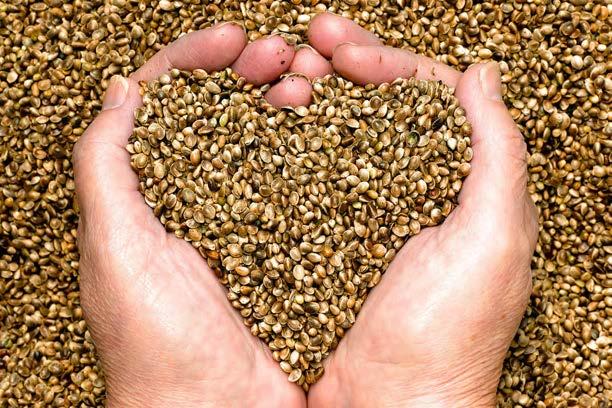
In addition, with production facilities in its home town of Oude Pekela, Netherlands, and in Romania, HempFlax manufactures a variety of hemp-derived durable raw materials and semi-finished products including fiber and building materials for construction, animal bedding, car parts, furniture and horticulture applications; nutraceuticals, including CBD and food from hempseed; plant genetics, seed and more.
In May, HempFlax announced that it had launched a new building supply division through its acquisition of the assets of Thermo-Natur, a German company that makes insulation from natural fibers.
Let’s Talk Hemp recently “Zoomed” in with HempFlax CEO Mark Reinders to learn more about HempFlax’s “total crop approach,” and the company’s strong belief that, as Reinders noted, “Quality begins in the field and not in the factory.”
120 LetsTalkHemp.com
What Is your background with HempFlax?
I grew up in a farm family and studied agri-business and crop production in college and have a Master’s degree in management. My father was one of the first farmers to grow hemp in the Netherlands in 1995, and my family still farms hemp. I joined HempFlax in 2001 as an intern. In 2008, I was appointed CEO of the HempFlax Group.

How do you work with farmers?
We work with about 70 large and small scale farmers, including farmers who are specialized in potatoes; they use hemp as a rotation crop. Our farmers also include flax and winter wheat in their rotations. The hemp crop is less labor intensive for them because we handle the harvest. Hemp doesn’t have many natural enemies and with its high rate of growth, it has weed suppressant capabilities. As such, we do not apply chemical crop protection during the crop. By introducing hemp in your crop rotations, you can improve the sustainability of your farm because you now have one less crop on which you have to apply chemicals. In addition, we do not use synthetic fertilizer on our farms in the Netherlands and Germany – we only apply animal manure, as there is so much available in these countries. In Romania, we are partly using manure, but there’s not enough available; however, we are increasing our use of natural fertilizers there year over year. In addition, we put the biowaste from our hemp manufacturing back into the field to improve the soil. Also, we are experimenting with 120 certified organic acres in Romania, as there is big demand for certified organic hempseed and hemp food.
Why do you conduct the harvest?
While we do not own all the fields, we contract with our farmers to conduct the harvest. For hemp, you need specialized equipment that is often too expensive for one farmer. We can provide that. HempFlax developed in cooperation with John Deere a specialized Double Cut Combine – the upper header takes the flowers and the lower header cuts the stalk, which has improved harvesting efficiency by allowing for one pass. The reason we handle the harvest ourselves is that we can determine the quality
in the field. We monitor the retting process – where we leave the stalks in the field for two to three weeks to naturally loosen the fiber from the core. This retting process is so important that we do it ourselves, and then we transport it to the factory for the decortication process.
How have you diversified your business?
Our business model is based on three revenue streams being separated in the field: seeds, stalks, and leaves and flower for CBD. We separate the higher quality hempseed for human consumption and the lower quality seed for animal feed. The seeds for oil, we breed ourselves. After retting and drying, the stalks are transported to our factories in Holland and Romania for decortication. In addition, now we own a third factory in Germany to manufacture insulation material. Compared to the total size of the market for insulation material, it’s definitely a niche, but it allows us to use more of the hemp crop and add value. But, as people have seen during the coronavirus crisis how quickly the Earth can regenerate itself, we have an opportunity to build a more sustainable economy than we had before, and hemp will definitely play a role in that. Additionally, animal bedding is doing very well; it sells well in the online consumer market. Hemp fiber for the automotive industry is very quiet, of course, as the auto industry has taken a hit, but we should see a recovery as the market opens up post coronavirus crisis.
What products do you offer for the nutraceutical market?
We provide CBD products in bulk and white label. We blend the extracts into different types of premixes. We blend with the hempseed oil we harvest, or if the customer prefers, we can blend with olive oil, MCT oil, sunflower oil and other oil blends. We also process into tinctures and capsules. For food manufacturers, HempFlax provides hempseed oil, protein powder and dehulled hempseed.
that is totally vertically integrated. We have been fortunate in that our business model has been relatively unaffected by this crisis because of the diversification we have. This is the time to change your business model to a more sustainable one. We have to rebuild our economy and be smart enough not to build it on top of the old polluting economy. We can increase our standard of living by using alternative naturally derived materials that have a lower footprint on the world; why use fiberglass when we can use hemp insulation? My wish for industry colleagues also is to stay focused and stay healthy, and we will survive this crisis.
Steven Hoffman is Managing Director of Compass Natural, providing brand marketing, PR, social media, and strategic business development services to natural, organic, sustainable and hemp/CBD products businesses. Compass Natural serves in PR and programming for NoCo Hemp Expo and Southern Hemp Expo, and Hoffman serves as Editor of the weekly Let’s Talk Hemp Newsletter, published by We are for Better Alternatives. Contact steve@compassnaturalmarketing.com.
What message can you share with your peers in the hemp industry?
The main message of a total crop approach is it’s not easy to do because you have to be active in a lot of different markets, from animal feed and bedding to nutraceuticals and building materials, and everything in between. The amount of know-how you need to in all those markets is tremendous, but if you succeed, you will have a profitable hemp operation
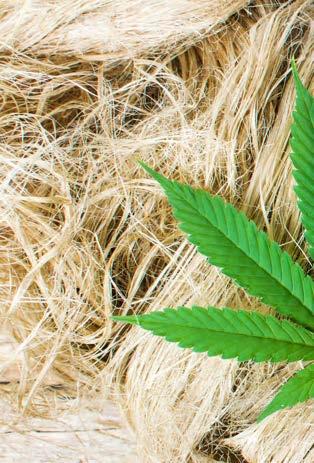
122 LetsTalkHemp.com
Adverse weather is the biggest risk to growing hemp


HEMProtect™ is a program that protects against multiple weather perils and can still be bought for this growing season
Available anywhere in the US hemp is legal to be grown

Coverage cannot be voided because of high THC

Growers, processors, investors and lenders alike are eligible to participate in this program
Be paid quickly and automatically when adverse weather causes losses on your hemp

HEMProtect™
By Jacob Bish
Hemp (Cannabis Sativa L.) is the only crop to have been used prominently throughout historical societies, its use then outlawed, and later adopted again by the 2018 Farm Bill. We are entering the second year of real commercial hemp farming and production in the United States. Examining the changes from last year to this, and those prior to the Farm Bill, we can hypothesize what hemp production in the coming years will look like.
2014 to 2019, the country experienced a large growth in hemp production – tripling annually from 10,000 acres across 15 states in 2016, to 511,000 acres licensed across 34 states in 2019. The majority of these acres were dedicated to CBD cannabinoid production – either for extraction or smokable flower. 2018 and 2019 saw a slightly higher interest in CBG hemp, but nothing compared to CBD.
Growing hemp for fiber has been spoken about a lot, but little to no acres have been commercially produced. Grain production has been occurring more often than fiber production but spoken about less frequently. 2020 has seen the most interest with attempts to grow hemp for grain and fiber production. Why has it taken this long to get more interest in grain and fiber, and what are the hurdles moving forward?
One of the largest obstacles to overcome was the interest in CBD. The price-point for CBD flower or extract was very lucrative for those beginning years. The drop in 2019 from $4.00 per point per pound to $0.75 – as tragic as it was for CBD producers – opened the door for more interest in grain and fiber production.

Outside of this price drop, the grain and fiber infrastructure has slowly been developing over the past several years, and it is now at the point when real sums of money can be invested into processing facilities. Harvest equipment that’s only been available in Europe has recently been introduced to the American market. Large-scale decortication equipment has been manufactured to separate the hurd and fiber components.
One of the largest obstacles moving forward is not the creation of consumer-ready products from hemp hurd, fiber, and grain, but the production of these items at a cost-competitive price. Everyone knows that we can manufacture cardboard, particleboard, bio-composites, and everything else under the sun out of hemp, but making it for the same or reduced price as traditional paper and plastic products is the real ticket to consumer acceptance.
This leads to the next issue: “How do we make hemp prod-
:AND BEYOND!
ucts cost-competitive?” The answer to that is mass production. We need hemp processors that can handle thousands of acres of hemp production a year. Only then can we have enough raw material to make enough products at a price point needed. However, growing thousands of acres leads directly into the next problem – genetic stability.
Hemp has been left behind in the genetic stabilization of crops that occurred in the mid 20th century. This leads to some inherent challenges in producing hemp at scale. When you work on the scale of several hundred acres or more, you must rely on standardized equipment to help you plant, manage, harvest, and process your crop. If you don’t work with this equipment, you have to do that by hand which isn’t feasible alone and is cost-prohibitive with manual labor. That standard equipment has to be able to work with the plants you have in the field. This works great when each plant is very similar to the next plant, so that the field looks uniform. However, hemp varieties are not as genetically stable as traditional crops, so the fields are not uniform. Now when you use your standard equipment to go through a field that isn’t uniform, you end up with yield loss from the crops, additional wear on your equipment, and less profit at the end of the day.
The final hurdle to overcome this genetic stability issue is acceptance of this crop by government agencies. If hemp was no longer treated like a drug, more universities and research programs would be willing to conduct breeding and variety trials. Variety stabilization would give producers a consistent crop. Data can be collected and disseminated so that producers had access to more resources to be successful. Sadly, we are behind the curve on this, and there’s not much we
can do to make up for it.
In 2020 and beyond, I see hemp production trending more towards large-scale grain and fiber production. This will take time, cooperation, and hard work from producers, processors, consumers, and researchers. The hurdles are real, but not insurmountable. Ultimately, hemp products can prove to be cost-competitive, while providing sustainable resources for consumer products.

BEYOND!
The Constitution of the United States intentionally does not include liberty and justice for all. It was written by slave owners. Much has been made of the alleged fact that the Constitution was written on hemp paper (sources suggest the first draft definitely was), but less attention has been paid to the 3/5 clause.

This provision set forth at the 1787 Constitutional Convention determined that slaves were to be considered 3/5 of a person, as opposed to a whole person or not counted at all, when assigning delegates in the House of Representatives based on a state’s population. The clause was seen then as a political power move, allowing Southern slaveholding states a disproportionately large number of delegates. But some anti-slavery representatives at the Constitutional Convention noted the cruel juxtaposition this would cause with the idea of a nation supposedly based on life, liberty, and the pursuit of happiness.
Gouverneur Morris, a Pennsylvania delegate, asserted that if slaves were counted, “the inhabitant of Georgia and South Carolina who goes to the Coast of Africa, and
NO J U S T I C E
in defiance of the most sacred laws of humanity tears away his fellow creatures from their dearest connections and damns them to cruel bondages, shall have more votes in a Government instituted for protection of the rights of mankind, than the Citizen of Pennsylvania or New Jersey who views with a laudable horror, so nefarious a practice.”
Sadly Morris was outvoted. The passage of the 3/5 clause set the stage for pro-slavery laws to be passed for the next seventy-odd years, including the Fugitive Slave Act of 1850 which required that all escaped slaves had to be returned to their masters. Under this model, the systemic racism we know today would soon evolve. Southern states were given unprecedented power in Congress and over the presidency for decades, and in all their policies were clear signs that they would never consider Blacks equal to whites. In 1861, Alexander Hamilton Stephens, Vice President of the Confederacy, made this explicit with his Cornerstone Speech, arguing that “Our new government’s foundations are laid… upon the great truth that the negro is not equal to the white man.” Even our historic heroes were no saints. Prior to the Southern states’ secession, Abraham Lincoln was in support of a plan which would let slaveholders keep
126 LetsTalkHemp.com
Intro: Honeysuckle Magazine
their slaves if it would help the nation remain whole.
We the people of these United States, in seeking to create a more perfect union, have time and again found that “liberty and justice for all” does not apply to Black Americans and other marginalized communities are suffering from the fallout of systemitc exclusion and oppression. We must reckon with our past in order to move forward.
We will keep insisting until real equality is reached, as evidenced across the globe during the current Black Live Matter Movement. Here, we present a new, hopeful, optimistic alternative to our constitution. Presented to you by a significant, young, Black life.
 By Taylor Custis
By Taylor Custis
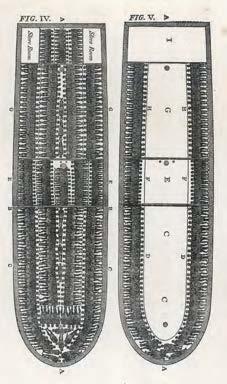
For the past several days, thousands of protestors in the United States and around the world have rallied in protest against the unjustifiable death of George Floyd. George Floyd, an unarmed black man, was killed in broad daylight while surrounded by four police officers, and his death was caught on camera. Even with video evidence, it took record numbers of protesters on the streets (in the era of COVID-19 no less), signing petitions, and calling up their representatives demanding justice. All four officers were charged, and now await convictions. But people have not ceased their protest.
While this event, the current protests, and the history of policing in America are highly important, it is essential to ask, Where do we go from here? How do we move forward? What will come of this mobilization?
People are educating themselves on the history of white supremacy within the U.S., and they’re beginning to connect the dots. Hashtags are going viral and people are posting protesting tips; on Twitter, users are recording and posting instances of police brutality towards protestors, among other necessary facts.
Law firms are offering protestors legal support pro bono. Individuals are cooking up hundreds of meals for protestors. People are donating money for the memorial fund of George Floyd in addition to the memorial funds of other black individuals who have lost their lives to the Police State.
But the fact is that police brutality, and police killings are not just common results of the Police State, they are inherent functions of a status quo which serves and
LetsTalkHemp.com 127
protects one group at the expense of countless others. This problem is systemic. It is not the result of one corrupt individual nor a poorly managed department. The problem is the unchecked power of officers, the lack of accountability and consequences. The problem is the original purpose of the police department: to monitor black people, to generate revenue for the state, and to harass and surveil citizens.
In 2019 alone, black individuals made up 24% of police killings, despite representing only 13% of the U.S. population. In that same year, a black person was three times more likely to be killed by a police officer than a white person. 99% of police officers who have committed murder in the last five years have not been charged with a crime. Police violence toward the black community is going unchecked.
My modest proposal is a world without the Police. I suggest that we alter the law enforcement system which at its core targets black people, poor people, other people of color, immigrants, and other more vulnerable populations, seeking to incriminate, to harm, and to dehumanize them.
I suggest that we institute a new amendment within the U.S. Constitution.
AMENDMENT XXVIII
1. Congress shall hereby redirect funds from state police budgets to community programs that support its citizens. Resources shall be redirected to EMT training, social workers, free health clinics, first responders, private security, neighborhood watch groups etc. The post of police officer as we know it today, will gradually be needed less and less as these resources begin to flow into these communities in this way.
The few police officers that remain shall be mandatorily retrained, spending a longer stint in the police academy. Completion of police training will require the completion of an ethics course and the completion of a university degree. Officers will be required to police their own areas, limiting the "othering" us vs. them narrative that comes with policing districts with inhabitants of a different ethnicity or racial background than the officers.

The police post in itself will be deprived of many of its present day functions, which have long served to perpetuate for-profit schemes. i.e. lying in wait to catch speeding vehicles, hiding speeding cameras, disguising their vehicles (to be more imperceptible to speeding vehicles) in ways where citizens cannot readily identify them.
2. Citizens shall no longer be imprisoned without trial. Imprisoning any accused person pending trial is hereby abolished. Poverty related issues such as debt, or lack of bail funds, shall no longer be considered criminal offenses.
3. The United States of America shall hereby abolish private prisons and turn any and all criminal detention centers, penitentiaries, and jails into rehabilitation centers. The focus of the U.S. correctional system should be to deliver justice and then help reintegrate ex-convicts-- those that are not an active threat to the public-- into society; above all, these former transgressors are human beings and are greater than the mistakes of their past.
Instead of depriving these individuals of the freedom to vote and the right to seek noble employment, the U.S. government will support them by funding programs which focus on mental health rehabilitation, financial literacy, and community building. The Legislative and Executive branches will do
a clean sweep of all laws which, by way of coded language, implicitly target the poor, the disadvantaged, the immigrants, the people of color, and other marginalized groups. For example, the criminalization of marijuana has historically been wielded in order to target and imprison African American people under the guise of the “War on Drugs” and will be abolished along with other laws, codes, and regulations that uphold a police-centric state.
4. The United States will decrease its militarization of national borders and end immigration bans that have been established on the basis of religion and race distinctions. ICE will be largely defunded in order to end the human injustices that take place against undocumented immigrants on a large scale i.e. children and other undocumented adults placed in detention facilities and cages, children of undocumented immigrants placed illegally within U.S. foster programs, mass deportation, and widespread familial separation. The goal of Homeland Security should not be to heavily police those who are different from us. The U.S.A. should always open its doors to immigrants, who have historically bolstered our economy and enriched our communities.
5. The U.S. military will be largely defunded. Large portions of the former annual budget of $721.5 billion will be distributed into education, allowing complimentary college for all U.S. citizens. Furthermore, these funds will be used to support a new U.S. cabinet position, one for history, which specializes in considering historical precedents before laws are made. Other government-run institutions like museums and public schools will be invested in heavily, in addition to complementary healthcare for all U.S. citizens. This will provide a greater quality of life to U.S. citizens and open the gates to those wishing to pursue higher education without access to sufficient means.
The U.S. military will withdraw troops and military involvement from foreign countries where the pursuit is profit (oil) driven, putting an end to war zones in foreign territories.

7. Citizens who wish to buy guns will be required to undergo background checks and vigorous tests in order to receive the proper licensing, especially in cases of advanced and automatic weapons. 2020 has been a historic year so far; why not keep up that trend? Let’s change our Constitution one amendment at a time. Let us begin a complicated surgery and uproot large parts of the injustice and white supremacy which persist at the core of this nation. Let us replace these ugly parts with something else entirely, like actual freedom and wellbeing.
The significance of a Constitutional Amendment is that it is more concrete and immovable, unlike federal law, national law, or even a bill. Furthermore, an amendment anchors itself to the original DNA of this nation. An amendment does not come and go with each presidential candidate nor administration. In fact, it is beyond the office of the president. It is the work of congress and state lawmakers. It has a wider, sweeping impact, one that would affect all fifty states. To channel real change, we must uproot our foundations and challenge our assumptions, no matter how intimidating this task may seem.
130 LetsTalkHemp.com here we come! 2021 NoCoHempExpo.com The Most Comprehensive Hemp Exposition, Trade Show & Conference on the Planet! MARCH 25-27 2021 DENVER COLORADO PRODUCED BY PRODUCED BY Rescheduled Dates event registration open in July 2020

 Powered
Powered























































































































 By Becky Long
By Becky Long





































































































 By Dan M., CBD Seed Labs
By Dan M., CBD Seed Labs








 All photos courtesy of John Dvorak
All photos courtesy of John Dvorak






















































 By Taylor Custis
By Taylor Custis





